There are 300+ species of spiders in Missouri. Sadly, the exact number is unclear due to the similarity of many species to each other.
Spiders are also a highly successful and diverse arthropod group, so narrowing down the precise number in Missouri is difficult. This guide will discuss more than 50 different types of spiders you can find in Missouri.
You’ll find that many of these fascinating and often feared creatures are not as scary as they seem. Spiders in Missouri inhabit various habitat types, from dry places to moist forest areas and woodlands.
Many species also live indoors in people’s houses, especially when the weather outdoors gets too cold to endure. You probably know that spiders often build webs to live and trap prey.
But do you know that not all spiders build webs? Many spider species are hunters that enjoy the thrill of stalking prey and stinging them into submission. Some species even hunt in the water!
If you’re ready to learn more about these fascinating arthropods, keep reading.
Table of Contents
- Spiders in Missouri
- Southern Black Widow
- Northern Black Widow
- Brown Recluse
- Texas Brown Tarantula
- Triangulate Orb-weaver
- Dark Fishing Spider
- Six-spotted Fishing Spider
- Filmy Dome Spider
- Grass Spiders
- Black-tailed Red Sheet-weaver
- Orchard Orb-weaver
- Rabid Wolf Spider
- Banded Garden Spider
- European Garden Spider
- Yellow Garden Argiope
- Spined Micrathena
- Furrow Spider
- Bark Crab Spiders
- White-banded Crab Spider
- American Green Crab Spider
- Running Crab Spiders
- Long-bodied Cellar Spider
- Giant Lichen Orb-weaver
- Goldenrod Crab Spider
- Red-spotted Ant-mimic Sac Spider
- Long-Palped Ant Mimic Sac Spider
- American Nursery Web Spider
- Bold Jumping Spider
- Brilliant Jumping Spider
- Trapdoor Spider
- Spitting Spider
- Broad-faced Sac Spider
- Golden Jumping Spider
- Tan Jumping Spider
- Marbled Orb-weaver
- Common House Spider
- Triangulate Combfoot
- Eastern Parson Spider
- Speckled Wolf Spider
- Bowl and Doily Spider
- Wetland Giant Wolf Spider
- Striped Lynx Spider
- Dimorphic Jumping Spider
- White-jawed Jumping Spider
- Star-bellied Orb-weaver
- Cat-faced Orbweaver
- Shamrock Spider
- False Black Widow
- Rabbit Hutch Spider
- Zebra Spider
- Arabesque Orbweaver
- White Micrathena
- Lined Orbweaver
- FAQ
- Conclusion
Spiders in Missouri
1. Southern Black Widow
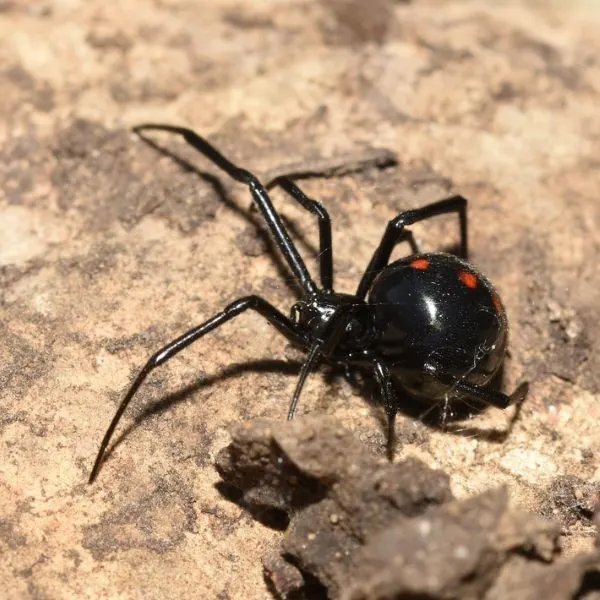
- Experience Level: Advanced
- Family: Theridiidae
- Scientific Name: Latrodectus mactans
- Other Names: Black Widow, Widow Spider
- Adult Size: Up to 0.5 inches
- Lifespan: 1 to 3 years
- Average Price Range: N/A
Black widows are arguably the most known spiders in Missouri and most of the US. If you’ve heard of these spiders, you probably know they are venomous. But there’s more than one type of black widow.
The two black widow spiders in Missouri are the northern black widow and the southern black widow. Both species are similar. As a result, many people mix them up.
You can identify southern black widows by the reddish-orange hourglass shape on their abdomens. The hourglass shape is complete in this species, with no break in the pattern.
Female southern black widows typically have round, enlarged abdomens. In contrast, most males have more oblong abdomens. Males are also smaller.
The rest of the body is pitch-black in both sexes. Their feet end in bristles, and they spin disorganized webs to catch prey.
Southern black widows are carnivorous solitary spiders. They feed on insects by trapping them in webs, injecting them with lethal venom, and then digesting them with enzymes. Common insects they feed on include grasshoppers, flies, and caterpillars.
Black widows are one of the few spiders in Missouri whose bites require medical attention. These arachnids are notorious for their venom, which is often said to be 15 times deadlier than a rattlesnake’s.
This species’ venom causes difficulty breathing, nausea, and muscle aches. While potentially fatal to children, elders, and immunocompromised people, the venom rarely causes death.
Despite their reputation, southern black widows scarcely bite people. A black widow is unlikely to bite you if you don’t disturb it. But it may bite you in self-defense if you’re aggressive toward it.
After mating, females sometimes kill then eat their male mating partners. This habit is how these spiders got the name black widow. However, these spiders are non-aggressive outside their mating rituals.
2. Northern Black Widow
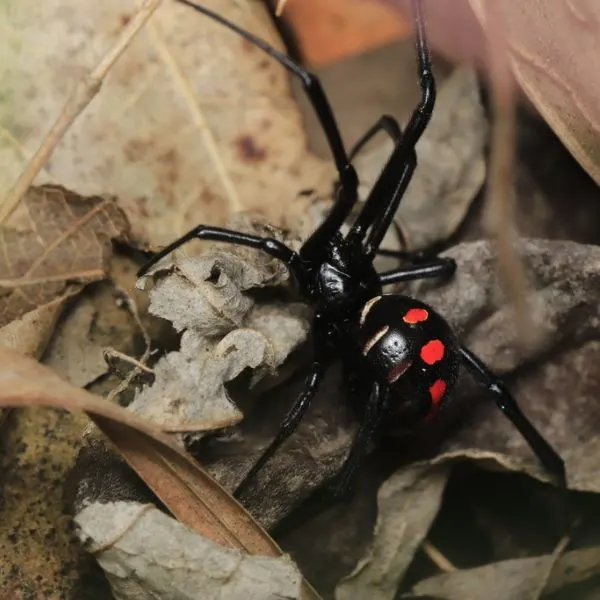
- Experience Level: Advanced
- Family: Theridiidae
- Scientific Name: Latrodectus variolus
- Other Names: Black Widow, Widow Spider
- Adult Size: Up to 0.5 inches
- Lifespan: 1 to 3 years
- Average Price Range: N/A
Northern black widow spiders are nearly identical to southern black widows. But you can tell them apart by examining the reddish-orange hourglass shape on their abdomens.
Unlike its southern sibling, the hourglass pattern on the northern black widow’s abdomen is not whole. Instead, it is broken in the middle to look like two opposite-facing triangles.
Young northern black widows also have red markings on the back of their abdomens, with white and yellow stripes on their sides. As these arachnids mature, females typically lose their lateral stripes. But adult males retain them.
Northern black widows are just as venomous as southern black widows, so be careful around them.
Venoms from males and juvenile females don’t cause as much damage as adult females. Like most black widows, the adult female northern black widow injects the most potent venom.
While death from these spiders is uncommon, their venom can cause severe systemic reactions. Seek medical attention immediately if you suspect a black widow has just bitten you, regardless of the species or sex.
Northern black widows are not aggressive spiders. They will only bite you if they have no choice. For example, they bite when you sit on them, try to crush them with your hands, press them against your skin, or wear clothes harboring them.
These arachnids have the same dietary requirements as southern black widows. They feed primarily on insects and other arthropods. Their tangled but sticky webs trap these prey.
3. Brown Recluse
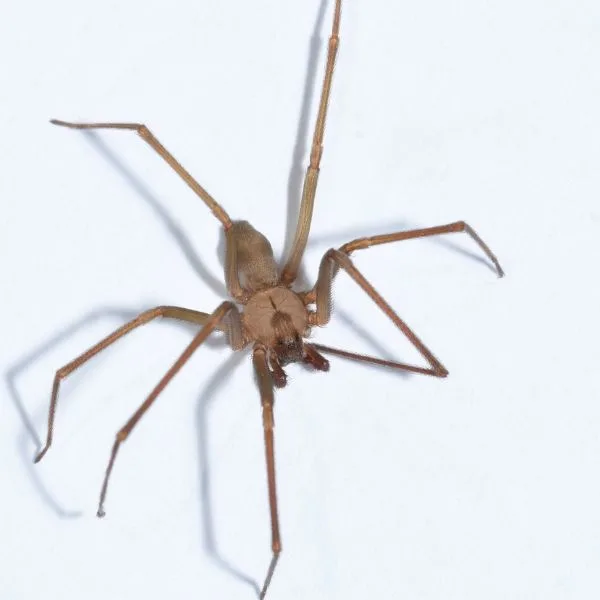
- Experience Level: Advanced
- Family: Sicariidae
- Scientific Name: Loxosceles reclusa
- Other Names: Violin Spider, Brown Fiddler, Fiddleback
- Adult Size: 0.24 to 0.8 inches
- Lifespan: 2 to 4 years
- Average Price Range: N/A
Brown recluses are one of the most venomous spiders in Missouri. So if you’re bitten by one, ensure to get it checked at a hospital immediately. The bite of this spider is rarely deadly. But it can leave a large unpleasant scar on your skin.
The toxin this spider injects is cytotoxic, killing off cells and tissues around the bite area. This reaction can create a deep ulcer that expands if you don’t treat it immediately.
Like most spiders, a brown recluse rarely bites without being disturbed. It’ll often try to escape if you threaten it. Many pretend to be dead or spin in the same area several times if you’ve backed them into a place with no escape.
Biting is generally a last resort for these spiders. So this spider is likely to bite you if you press your skin against it, wear a vest harboring it, or crush it.
Brown recluse spiders love to stay hidden from humans. They generally hide in wall cracks or crevices and uninhabited rooms. You can also find them in shoes and clothing, especially those you haven’t worn in a while.
Brown recluse spiders are tan to dark brown. Unlike most spiders with 8 eyes, these arachnids have only 6 eyes. They also have bristle-less legs.
A brown recluse also has a mark resembling a violin on its back, just behind its head. While this violin shape is not unique to this spider, it is an effective means of identification.
These spiders are carnivorous, so they feed on several types of insects. Crickets, flies, and beetles are their common prey.
4. Texas Brown Tarantula
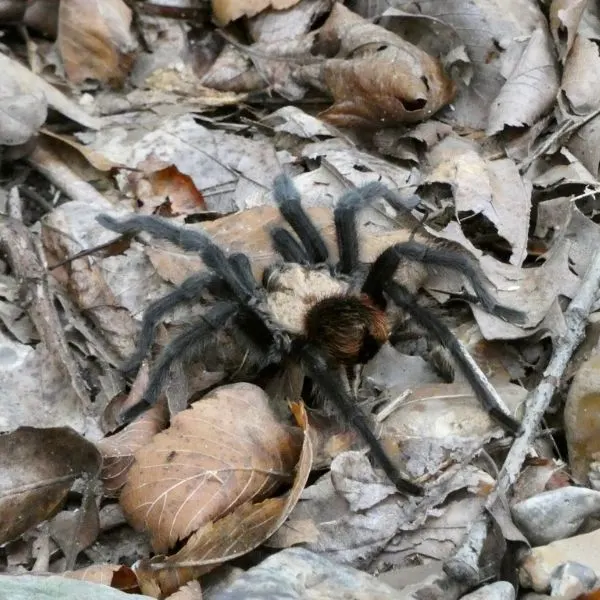
- Experience Level: Beginner to Intermediate
- Family: Theraphosidae
- Scientific Name: Aphonopelma hentzi
- Other Names: Ordinary tarantula, Missouri Tarantula, Oklahoma Brown Tarantula
- Adult Size: Up to 2 inches
- Lifespan: 10 to 30 years
- Average Price Range: N/A
Texas brown tarantulas are generally hairy spiders that inflict painful but mildly venomous bites. Their bites aren’t serious, so you typically don’t need medical attention. If you get stung by one, the pain often wears off in a short time.
Texas brown tarantulas are the biggest spiders in Missouri. Despite their size, they are generally non-aggressive. People only get stung by accident or through forced skin contact. These arachnids often stand on their hind legs to seem bigger and intimidate predators when cornered.
Female tarantulas can live for several decades, compared to males who rarely survive a year after full maturity.
You can find these spiders in dry environments and places like the undersides of rocks and logs. Many Texas brown tarantulas also live in ground tunnels. While they can create these burrows themselves, many simply use burrows other animals have created and abandoned.
You can identify these spiders by their hair-covered bodies. They have dark brown legs and bodies, while the hair on the carapace is slightly reddish. Their large size and hairy bodies can make them seem intimidating, which is why many people believe they are deadlier than they really are.
Ordinary tarantulas tend to avoid being seen, but sightings in Missouri are more common in fall and late summer. Most of these tarantulas range in the southern and central parts of the state.
Missouri tarantulas feed on insects like crickets. They often spin webs at the entrance of their burrows to catch prey. When a web traps prey, these spiders detect it and rush to consume the prey.
5. Triangulate Orb-weaver
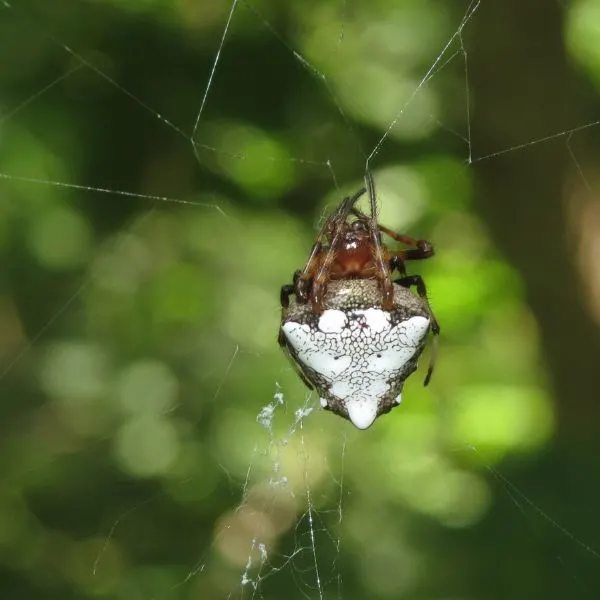
- Experience Level: Beginner to Intermediate
- Family: Araneidae
- Scientific Name: Verrucosa arenata
- Other Names: Arrowhead Spider, Arrowhead Orb-Weaver
- Adult Size: Up to 0.8 inches
- Lifespan: 1 year
- Average Price Range: N/A
You can find triangulate orb-weavers throughout Missouri’s woods. Females are generally larger than males, typical of most spiders in Missouri.
These stunning spiders have a triangular abdomen. In addition, the upper side of the abdomen has a triangular, butterfly, or arrowhead-shaped patch on it. This patch may be yellow, white, or pink.
Besides this colored patch, the rest of the spider is dark brown. The body is also covered with bristles, but it is nowhere as hairy as tarantulas. Its bristles help deter potential predators.
Arrowhead orb-weavers are safe to be around. They may bite if pressed close to your skin, but their bite is harmless to people.
They generally consume arthropods, so their diet consists of many flying insects like flies. They spin delicate webs to trap mostly tiny insects. Unfortunately, large prey may be able to escape from the webs.
These orb-weavers tend to spin their webs only in the evenings and early mornings. They remove these webs after daybreak and only weave new ones after sunset. Unlike other orb-weavers in Missouri, this species hangs upright in its web’s center.
You are most likely to find arrowhead orb-weavers in the weeks between summer and fall. That’s because these spiders enjoy plenty of exposure to sunlight.
6. Dark Fishing Spider
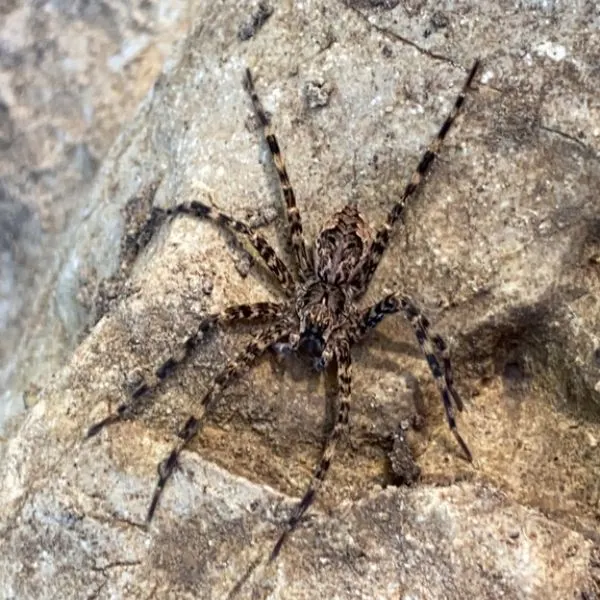
- Experience Level: Beginner to Intermediate
- Family: Pisauridae
- Scientific Name: Dolomedes tenebrosus
- Other Names: Fishing Spider
- Adult Size: 0.27 to 1 inches
- Lifespan: 1 year
- Average Price Range: N/A
Fishing spiders are wandering predators with feet adapted to movement on ground and water surfaces. As a result, you will often find them close to water. But this isn’t the case with every species. The dark fishing spider, for instance, spends most of its time in coastal woods and often enters people’s homes.
These spiders avoid contact with humans, and bites are extremely rare. Still, females are more ferocious than males. They tend to bite when cornered instead of running away. Fortunately, the effect of this bite is mild. But it hurts because their fangs can pierce the skin.
Much is unknown about this species, but mating records show that females likely finish mating by killing their male partners.
Dark fishing spiders are not web-builders. Unlike many spiders that trap prey in webs, these arachnids actively stalk their prey. They often feed on small fish and insects they find swimming in the water, but they also eat slugs and nearly anything they come across.
These arachnids are quite hairy and large, so many mistake them for other species like wolf spiders. They have brownish-gray bodies with brown and black markings, while their legs are alternating broken brown and black bands.
When you see a dark fishing spider, it will most likely be resting with its legs stretched out in every direction.
7. Six-spotted Fishing Spider
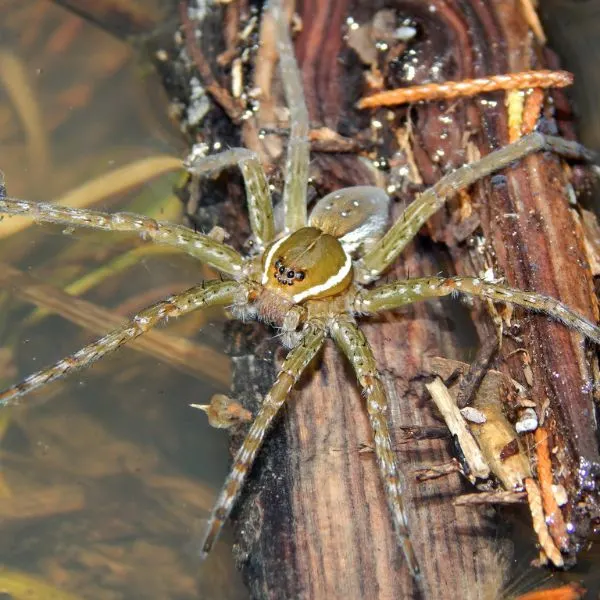
- Experience Level: Beginner to Intermediate
- Family: Pisauridae
- Scientific Name: Dolomedes triton
- Other Names: Fishing Spider
- Adult Size: 0.5 to 0.75 inches
- Lifespan: 1 year
- Average Price Range: N/A
At first glance, the six-spotted fishing spider may seem misnamed. That’s because there are more than six spots on this fishing spider’s abdomen. However, the number only refers to the six dark spots on the underside of this arachnid’s abdomen.
Like dark fishing spiders, people often mistake six-spotted fishing spiders for wolf spiders. Both species are somewhat related, and they look similar when fully outstretched.
Females are twice as big as males, sometimes consuming their male partners after mating. The reason for this behavior is unclear. They also often spin silk webs to attract male mates and house their eggs.
Fishing spiders like this species don’t build webs to trap prey. Instead, they hunt prey they come across and eat almost anything. That’s why they are called opportunistic feeders.
This species is well-adapted for walking on water surfaces, and it can stay submerged for several minutes without resurfacing.
When hungry, this arachnid often eats aquatic insects on the water surface, including other spiders. Sometimes it dives deep into the water to catch prey significantly bigger than it, such as fish and tadpoles.
Six-spotted fishing spiders are venomous. When they catch prey, they often bite the animal and paralyze it with their venom. Fortunately, the effect of this venom on humans is negligible.
You can find these spiders in coastal areas beside streams and ponds. But they are also comfortable in dry habitats.
8. Filmy Dome Spider

- Experience Level: Beginner to Intermediate
- Family: Linyphiidae
- Scientific Name: Neriene radiata
- Other Names: Sheetweb Weavers
- Adult Size: 0.14 to 0.2 inches
- Lifespan: 1 year
- Average Price Range: N/A
You can find filmy dome spiders throughout Missouri. These arachnids favor woodlands and often restrict themselves to these areas. But they also sometimes live in people’s houses.
These spiders are famous for their large silk webs, which resemble a bowl or dome turned upside-down. This dome-shaped web is how the species gets its name.
Filmy dome spiders usually spin webs in low, dense bushes or vegetation, woodpiles, and rock outcroppings. You’ll also often spot their webs near walls in houses.
Filmy dome spiders come in multiple color patterns. However, most have black to dark or yellowish-brown bodies with yellow or white stripes running down their sides. Their abdomens are mostly yellow with several brown markings.
Like most spiders, males here are smaller than females. Females also lack pedipalps but possess larger abdomens than their male counterparts.
Filmy dome spiders like to stay hidden. They are primarily nocturnal, so you’re more likely to encounter them at night. In homes, they stick to wall corners and avoid straying far into open spaces.
You’re unlikely to experience any serious reaction to a filmy dome spider bite. While you may experience mild itching, it has no significant toxic effect.
These arachnids are carnivorous, so insects make up most of their diet. They eat insects like flies, mosquitoes, and ants caught in their silk webs.
9. Grass Spiders
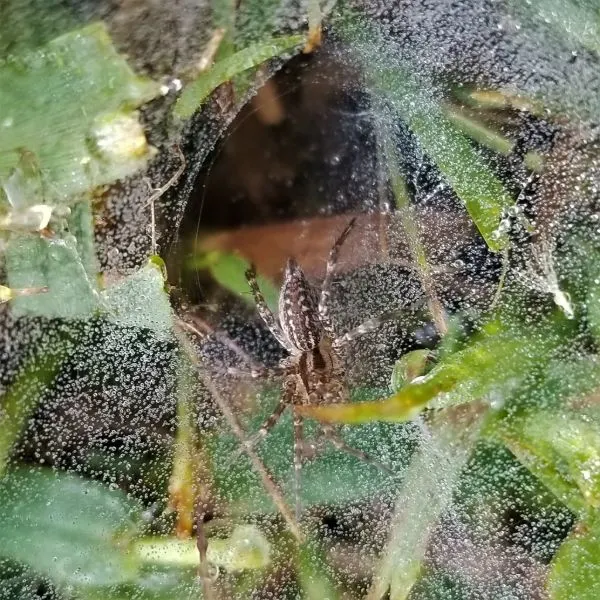
- Experience Level: Beginner to Intermediate
- Family: Agelenidae
- Scientific Name: Agelenopsis spp.
- Other Names: Funnel Weavers, Funnel Web Spiders, Sheet Web Spiders, Ground Spiders
- Adult Size: 0.4 to 0.8 inches
- Lifespan: 1 year
- Average Price Range: N/A
Grass spiders spin horizontal sheet-like webs with a downward-facing funnel-shaped web under. This funnel typically connects to the spiders’ shelter, which could be the mouth of a crack or a small portion of vegetation.
These spiders build webs to catch prey and retreat to the funnel, waiting for prey to land on the sheets. As soon as an insect lands on the web or walks over it, the spider will pounce. Their diet includes arthropods like moths, butterflies, and false spiders like harvestmen.
There are about four species of grass spiders in Missouri. You may have difficulty distinguishing them because they have similar patterns. They have a nearly round carapace with a light stripe in the middle of two dark brown bands.
Their abdomens are typically brown, but you’ll notice a jagged reddish-brown line with cream borders on either side. They also usually have cream or yellowish-brown legs. As is typical of spiders, female grass spiders are slightly larger than males.
You have nothing to fear from these arachnids. They are not aggressive, so you’re unlikely to get bitten. But if you get bitten, their venom isn’t toxic enough to harm you.
10. Black-tailed Red Sheet-weaver
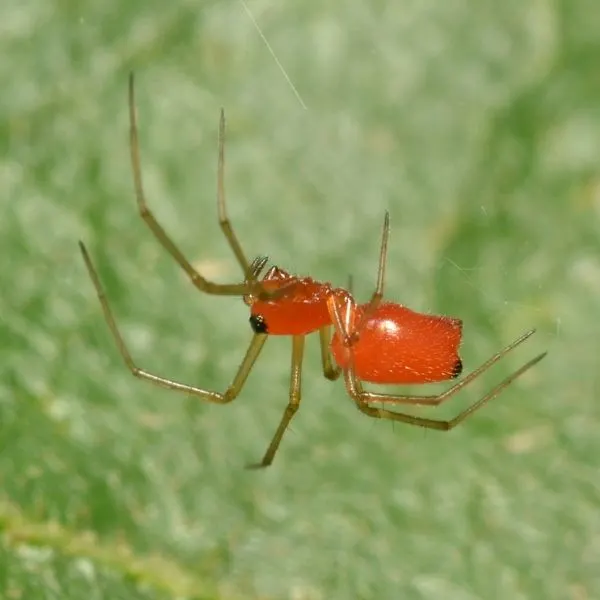
- Experience Level: Beginner to Intermediate
- Family: Linyphiidae
- Scientific Name: Florinda coccinea
- Other Names: Red Grass Spider
- Adult Size: 0.12 to 0.16 inches
- Lifespan: 1 year
- Average Price Range: N/A
Sheet-weavers are named after the kinds of webs they build. Black-tailed red sheet-weavers, for example, spin their webs horizontally in sheet-like layers. These silky webs are not sticky, but the tangles the spiders create above the sheets successfully trap insect prey.
Although these spiders are physically quite small, their population isn’t. This fact is especially true when you consider the family this species belongs to. Sheet-weavers are the second most successful spider species on earth.
Black-tailed sheet-weavers do not pose any threat to humans. If you see one, you need not worry. It rarely bites unless it has no choice. Even when it does, the bite of this species is harmless to most people.
As their name suggests, black-tailed red sheet-weavers have black tails. Their abdomen and cephalothorax are sometimes reddish-orange instead of deep red. Their legs also seem to be translucent dark green with sparse spines.
11. Orchard Orb-weaver

- Experience Level: Beginner to Intermediate
- Family: Tatragnathidae
- Scientific Name: Leucauge venusta
- Other Names: Long-jawed Orb-weaver
- Adult Size: 0.14 to 0.3 inches
- Lifespan: 1 year
- Average Price Range: N/A
Orchard orb-weavers are abundant in Missouri woodlands and areas with short, dense vegetation. They build horizontal webs that may be more than half a meter wide. You’ll likely spot orchard orb-weavers hanging down the center of their webs.
Despite their abundance, you may have difficulty spotting these arachnids in their natural habitats. This is because they often drop from their nests and take shelter under litter or thick vegetation when approached. They also generally avoid wandering in open spaces.
Orchard orb-weavers are harmless to you. Anyone you come across will flee from you rather than defend itself. In extreme cases, these spiders bite. But they lack venoms potent enough to affect you.
Adult orchard orb-weavers tend to build higher nests than juveniles. While juveniles typically keep their nests on the same level as low vegetation, adults may build nests nearly 6 feet 6 inches above the ground.
As is typical of arachnids, orchard orb-weavers primarily feed on arthropods which they catch using their webs. Due to the height of these webs, their diet consists of many flying and hopping insects like flies, crickets, and mosquitoes.
Orchard orb-weavers are beautiful and multicolored. They have enlarged abdomens sporting various colors like light or dark green and yellow. A similar pattern appears on the carapace, with the sides bearing darker shades.
Adult female orchard orb-weavers tend to be slightly bigger than their male counterparts.
12. Rabid Wolf Spider

- Experience Level: Beginner to Intermediate
- Family: Lycosidae
- Scientific Name: Rabidosa rabida
- Other Names: Wolf Spider
- Adult Size: 0.5 to 0.8 inches
- Lifespan: 2 years
- Average Price Range: N/A
Rabid wolf spiders are not rabid, and they look nothing like wolves. But they are excellent hunters. Unlike most spider species, they track down prey to eat instead of spinning webs to catch them.
They have brown and white stripes on their carapace. The topmost pair of eyes are located in the middle of the brown stripes, and both eyes have a white mark resembling an eyebrow above them. In addition, the first pair of legs in males are dark brown to black.
The abdomen has a solid brown middle stripe bordered by tan stripes. You’ll also notice several whitish spots towards the end of the brown middle stripe.
Sometimes, you may have difficulty seeing the abdominal pattern on females that recently hatched their eggs. That’s because their tiny offspring crowd their abdomens and ride along with them until they can fend for themselves.
Female rabid wolf spiders have such a high maternal instinct that they carry their eggs around in spinnerets until they hatch. This behavior is different from other spiders that protect their eggs in nests but don’t take them everywhere.
Many people have difficulty identifying wolf spiders in Missouri down to species level. While there are over 250 wolf spider species in North America, many look too similar to distinguish without help.
Fortunately, none of the wolf spiders in Missouri inflicts medically significant bites. So you don’t need to panic if you encounter one in your home.
13. Banded Garden Spider
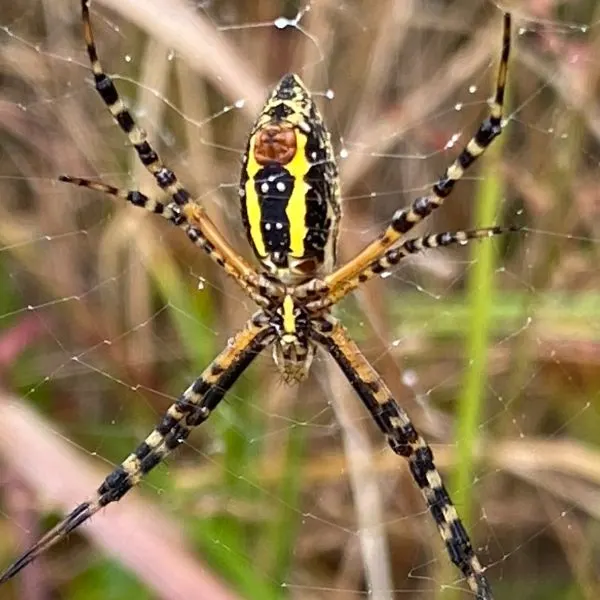
- Experience Level: Beginner to Intermediate
- Family: Araneidae
- Scientific Name: Argiope trifasciata
- Other Names: Banded Argiope
- Adult Size: 0.59 to 0.98 inches
- Lifespan: 1 year
- Average Price Range: N/A
The banded garden spider is an orb-weaver bearing several markings on its body. The abdomen is yellow with several transverse lines on its back. These lines are a mix of short black and white lines with long black lines running from side to side.
The lines on the abdomen are why this species is called a banded spider. The carapace is covered with several white or silver hairs and is smaller than the abdomen. Females of this species are 3 to 5 times as big as males.
The banded argiope is active in the daytime. Like many orb-weavers, it relies on its wide webs to catch prey. It mostly feeds on smaller insects and animals, but it also eats prey as big as wasps.
The banded argiope paralyzes its prey with venom before feeding on it. Fortunately, this venom is not potent enough to harm people.
You can find banded garden spiders in Missouri’s bushes and tall grasslands. These arachnids often build nests in open places.
14. European Garden Spider
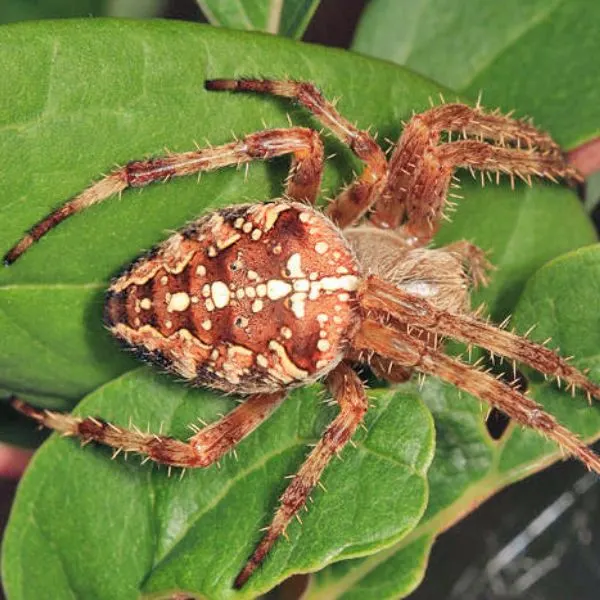
- Experience Level: Beginner to Intermediate
- Family: Araneidae
- Scientific Name: Araneus diadematus
- Other Names: Cross Spider, Crowned Orb-weaver, Diadem Spider
- Adult Size: 0.22 to 0.79 inches
- Lifespan: 1 year
- Average Price Range: N/A
The European garden spider has long, slim, spiny legs. Its abdomen has a stunning bilaterally symmetrical color pattern. If you look closely at this abdomen, you’ll notice a series of white or yellow dots that form a cross in the middle.
Like many species, female European garden spiders have wider abdomens than males. The body of both sexes has alternating areas of gray, light yellow, and dark brown. They also have tiny eyes on their carapaces, but you have to hold them up to notice.
As is typical of orb-weavers, this species spins fine webs and hangs upside-down in the middle. The European garden spider is a carnivore that relies on its net to catch prey. So it usually waits patiently for a vibratory signal that its web has caught prey.
15. Yellow Garden Argiope
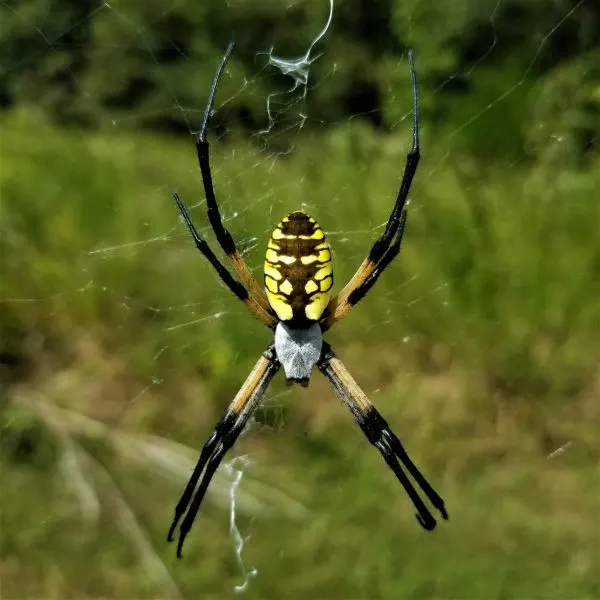
- Experience Level: Beginner to Intermediate
- Family: Araneidae
- Scientific Name: Argiope aurantia
- Other Names: Black And Yellow Argiope, Black And Yellow Garden Spider, Zipper Spider, Zigzag Spider, Writing Spider, Corn Spider, McKinley Spider, Golden Garden Spider, Steeler Spider
- Adult Size: 0.75 to 1.1 inches
- Lifespan: 1 year
- Average Price Range: N/A
As the name suggests, this stunning orb-weaver is known for spinning webs in gardens and places lush with green vegetation. Yellow garden argiopes may sometimes build their nests around people’s homes.
You can find these beautiful spiders in vegetation-rich areas, such as dense grasslands. These garden spiders have 3 claws per foot, which help them spin intricate webs. This trait is unique to orb-weavers. Regular spiders have only 2 per foot.
Yellow garden spiders have a pleasant physical appearance. They have largely yellow, oval abdomens with broad black stripes. The mid-black stripe on the back has several pairs of yellow or white teardrop markings along its length.
Yellow garden spiders have silvery hairs on their cephalothorax. You’ll also notice yellowish stripes along these spiders’ long black legs. The legs are more yellow near the cephalothorax, but the black is dominant throughout the length of the legs.
You’ll often see black and yellow argiopes hanging head-down from the center of their elaborate silky webs. The center of these webs sports a vertical zigzag silk band. This band is a stabilimentum, but its entire function is not clear.
Yellow garden spider webs may be as wide as 6 feet 6 inches. These arachnids use their nests to catch insects like grasshoppers, which they feed on. Sometimes, other species feed on insects trapped in these spiders’ webs.
You have nothing to fear from yellow garden spiders. While they may bite if given no choice, their bites are harmless to humans. Bites from these spiders are only effective at paralyzing prey.
Female yellow garden spiders are larger than males of the same age.
16. Spined Micrathena

- Experience Level: Beginner to Intermediate
- Family: Araneidae
- Scientific Name: Micrathena gracilis
- Other Names: Castleback Orb-weaver
- Adult Size: 0.2 to 0.4 inches
- Lifespan: 1 year
- Average Price Range: N/A
These spiders are beautiful. They have amber carapaces and white abdomens covered with dark, spiky protrusions. While the color of these spiders varies widely, most have a consistent white and black pattern with glossy black legs.
This characteristically spiny abdomen is only present in females of the species. Males lack this feature and don’t inhabit open spaces as frequently as females. Females are also significantly larger than males.
You’ll often find the spined micrathena in coastal forests and woodlands abundant in oak and timber trees. It spins complex webs specialized for catching flying insect prey. Their webs generally have a long silk line linking to a tree branch above.
These arachnids are primarily diurnal, so you’re likely to come across them during the day. They scarcely bite. But even when they do, the bite is harmless to humans.
17. Furrow Spider

- Experience Level: Beginner to Intermediate
- Family: Araneidae
- Scientific Name: Larinioides cornutus
- Other Names: Furrow orb-weaver, Furrow Orb spider, Foliate spider
- Adult Size: 0.2 to 0.6 inches
- Lifespan: 1 year
- Average Price Range: N/A
You’re most likely to encounter furrow spiders in damp areas near streams or ponds. They avoid dry places and favor areas with wet vegetation. Many also take shelter in houses that provide some level of moisture.
These orb-weavers often spin webs to capture prey during the day. Every evening, they eat their silk webs and respin them later to trap new prey. Insects like flies and mosquitoes make up the bulk of their diet.
Furrow spiders have large, oval abdomens and vary in color. These colors range from red to gray or black. They also typically have arrow-shaped markings on their abdomen. This marking points anteriorly and is also present on their legs.
Female furrow orb-weavers are larger than males.
18. Bark Crab Spiders
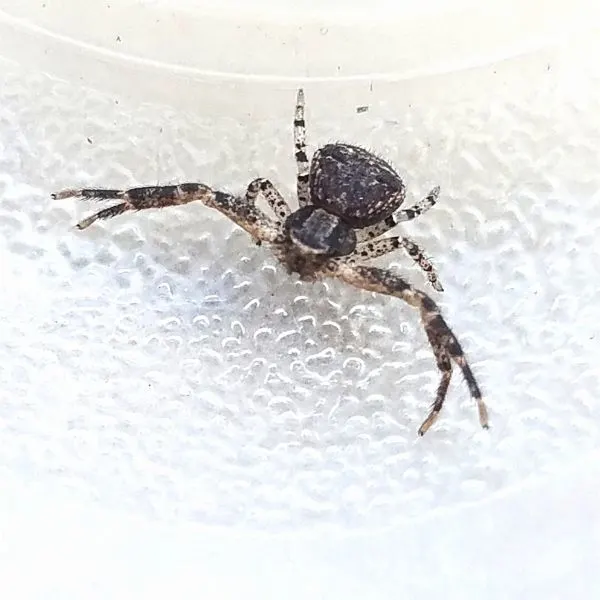
- Experience Level: Beginner to Intermediate
- Family: Thomisidae
- Scientific Name: Bassaniana
- Other Names: Ground Crab Spiders
- Adult Size: 0.18 to 0.4 inches
- Lifespan: 1 year
- Average Price Range: N/A
Bark crab spiders are camouflage experts. They have gray to brown skins that blend perfectly well with leaves and tree barks, which they often hide under. This cryptic coloration is where the bark in their name comes from.
Look closely at these arachnids, and you’ll notice several yellow to white markings on their bodies. These markings are most obvious around the abdomen.
Like other crab spiders, bark crab spiders have several tiny spines covering their bodies. Their first 2 pairs of legs are also larger and stronger than the last 2.
These arachnids are widely distributed in Missouri. So you’re likely to encounter them in forests, woodlands, and fenceposts in residential areas. However, you may have difficulty spotting them due to how well their coloration blends into their surroundings.
Bark crab spiders don’t pose any significant threat to humans. So if you get bitten by one, you’re unlikely to experience more than mild discomfort.
These arachnids focus their energy on catching prey, not humans. They feed on plenty of insects, including flying species like butterflies.
There are several species of bark crab spiders in Missouri. However, you’ll have a hard time telling them apart without expert help.
19. White-banded Crab Spider
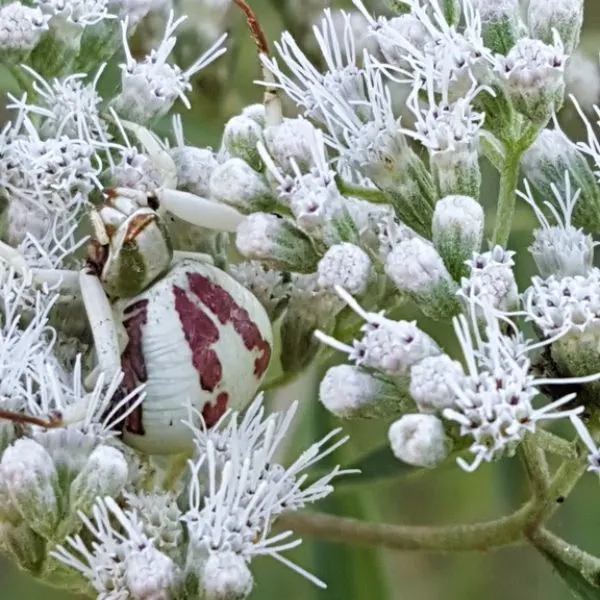
- Experience Level: Beginner to Intermediate
- Family: Thomisidae
- Scientific Name: Misumenoides formosipes
- Other Names: Red-banded Crab Spider
- Adult Size: 0.125 to 0.5 inches
- Lifespan: 1 year
- Average Price Range: N/A
Hearing this crab spider referred to as both red-banded and white-banded may confuse you. But both names refer to the same species. These small crab spiders are often yellowish-brown or whitish-yellow.
They often have cream or yellow legs and a greenish carapace. The carapace has thin yellowish-brown (reddish) stripes with a broad, whitish-yellow band running between them. So calling them white-banded or red-banded is correct.
The abdomen of red-banded crab spiders is sometimes plain. But many of them have several reddish spots that form a Y-shape on their abdomen.
A fascinating thing about these spiders is their ability to change coloration. For example, females often switch their colors between white and yellow to match the closest flower. While this color change may take over 3 days, it helps them catch prey more easily.
Unlike web-building spiders, red-banded crab spiders don’t catch prey by trapping them in webs. Instead, they wait patiently on flower parts for pollinators they can eat. Blending into the surroundings makes it difficult for prey to spot them.
Red-banded crab spiders have large, powerful forearms, which they use to seize prey. While pollinators are their typical victims, these arachnids also often eat other spiders.
Their venom is effective at immobilizing prey but is harmless to human beings. So, unless you press your skin against one in error, these arachnids are unlikely to bite you.
You’ll have difficulty spotting these spiders on your garden flowers due to their cryptic coloration. Still, adults are easier to notice than spiderlings because of their size difference.
Like most spiders, female red-banded crab spiders are larger than males.
20. American Green Crab Spider
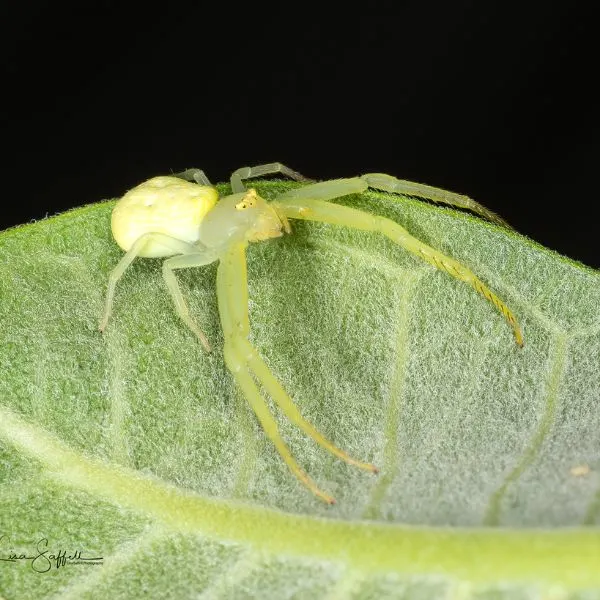
- Experience Level: Beginner to Intermediate
- Family: Thomisidae
- Scientific Name: Misumessus oblongus
- Other Names: Foliage Flower Spider, Ridge-Faced Flower Spider
- Adult Size: 0.125 to 0.5 inches
- Lifespan: 1 year
- Average Price Range: N/A
American green crab spiders are active predators. Unlike other web-spinning spiders, they do not spin webs to trap prey. Instead, these arachnids actively pursue insect prey and sting them before eating. These insects include moths, butterflies, grasshoppers, and other spiders.
These arachnids are not harmful to humans. They aren’t aggressive towards people, and bites are rare. So except you’re allergic to spider venom, you’re unlikely to suffer any serious reaction.
American green crab spiders spin silk webs to protect their offspring. When a female lays eggs, she spins a protective silky cocoon around them and guards them. Unfortunately, it often dies before the eggs hatch.
Like most spiders, females are twice as large as males.
21. Running Crab Spiders

- Experience Level: Beginner to Intermediate
- Family: Philodromidae
- Scientific Name: Philodromus spp.
- Other Names: Crab Spiders
- Adult Size: Up to 0.75 inches
- Lifespan: 1 year
- Average Price Range: N/A
These flat spiders range from brown to gray and bear little markings on their bodies. Like most crab spiders, running crab spiders possess larger and stronger forelegs. The second pair is the longest leg pair.
Running crab spiders hunt their prey without using webs. They are swift when chasing prey and use their cryptic coloration to their advantage. Insect prey often doesn’t spot them until it is too late.
Rather than for trapping insects, running crab spiders spin silk webs to protect their eggs. They wrap their eggs in these cocoons and guard them for as long as possible.
You can find these arachnids in humid forests and vegetation. More often than not, these forests are near streams and other aquatic bodies. However, you may also encounter them in buildings and people’s houses.
Running crab spiders don’t attack humans unprovoked, and their bites are painful but harmless. However, if you’re allergic to spider venom, you may experience more serious symptoms. See a doctor if you experience nausea or headaches following a bite from this species.
22. Long-bodied Cellar Spider

- Experience Level: Beginner to Intermediate
- Family: Pholcidae
- Scientific Name: Pholcus phalangioides
- Other Names: Daddy Longlegs, Granddaddy Longlegs, Daddy Longlegger, Carpenter Spider, Skull Spider, House Spider, Vibrating Spider
- Adult Size: Up to 0.4 inches
- Lifespan: 2 years
- Average Price Range: N/A
As their name suggests, you’ll often find these arachnids in home cellars. You may have heard that these arachnids are the most venomous spiders in Missouri or North America, only that they cannot penetrate human skin.
Long-bodied cellar spiders can penetrate human skin. But their bite is harmless to humans, so the story about their lethal venom is false. At most, you’ll experience a mild reaction or itch where they bite you.
These arachnids mind their business, except when snacking on prey. They spin silk webs and are typically non-aggressive, often running away when threatened by humans.
These spiders possess long legs often up to 6 times their body length. Like other spider species, females are larger than males. They are often called daddy longlegs because people generally mistake them for the original daddy longlegs (harvestmen) species.
Long-bodied cellar spiders are abundant in Missouri and most of the US. However, these spiders are originally an invasive species introduced from Europe. They feed on insects and are considered a threat to native spiders.
23. Giant Lichen Orb-weaver

- Experience Level: Beginner to Intermediate
- Family: Araneidae
- Scientific Name: Araneus bicentenarius
- Other Names: Orb-weaver
- Adult Size: Up to 1 inch
- Lifespan: 1 year
- Average Price Range: N/A
The giant lichen orb-weaver comes in several colors, such as white, black, grayish-green, and orange. The giant in this arachnid’s name is not entirely due to its size. It is also one of the heaviest orb-weaving spiders in Missouri.
This multicolored arachnid has orange legs with black bands, creating an alternating pattern. The ground color of the body is grayish-green, and the abdomen has several whitish markings.
If you aren’t great at identifying spiders, you may mistake it for a European garden spider. The most obvious difference is the absence of cross-shaped patterns on the upper abdomen of giant lichen orb-weavers.
This species’ webs can be as wide as 8 feet and are one of the widest webs made by orb-weavers. Unlike other spiders, the giant lichen orb-weaver scarcely stays in the center of its web.
The giant lichen orb-weaver spends its time by the web’s edges, waiting for it to trap insect prey. It receives a signal when the net traps an insect. Then it moves towards the prey to consume it.
Giant lichen orb-weavers are nocturnal. Since they are often preyed on by reptiles and birds, they prefer to stay hidden till dark.
24. Goldenrod Crab Spider
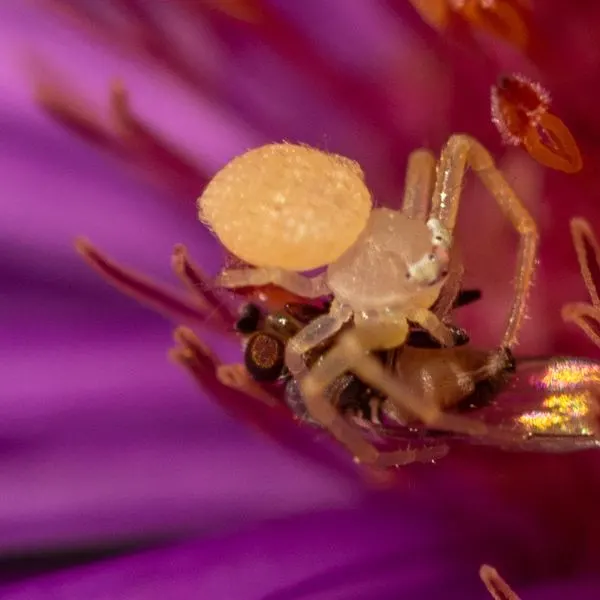
- Experience Level: Beginner to Intermediate
- Family: Thomisidae
- Scientific Name: Misumena vatia
- Other Names: Smooth Flower Crab Spider
- Adult Size: 0.125 to 0.75 inches
- Lifespan: 2 years
- Average Price Range: N/A
You can find the goldenrod crab spider in prairies and flower fields all over Missouri. It loves to stay in white or yellow flower heads and can change its color to match its surroundings. This color change is usually only between yellow and white.
Goldenrod crab spiders have white to yellow bodies and are difficult to differentiate from similar species. Females have white abdomens with a broad, red, or orange stripe on each side.
Female goldenrod spiders have 3 spines on their first leg pair but are spineless otherwise. They also have a dark brown to black border on their whitish or yellow carapace. The legs of females are beige to white.
Unlike females, the carapace of male goldenrod crab spiders is green to yellow. Their first pairs of legs are also purplish.
These arachnids do not build webs to catch prey. Instead, they use their cryptic coloration to hide in flowers and wait for prey. Goldenrod spiders then pounce on insects that come to pollinate the flowers.
Goldenrod spiders are not dangerous to humans. Bites are rare, and they do not cause serious damage when they do.
25. Red-spotted Ant-mimic Sac Spider
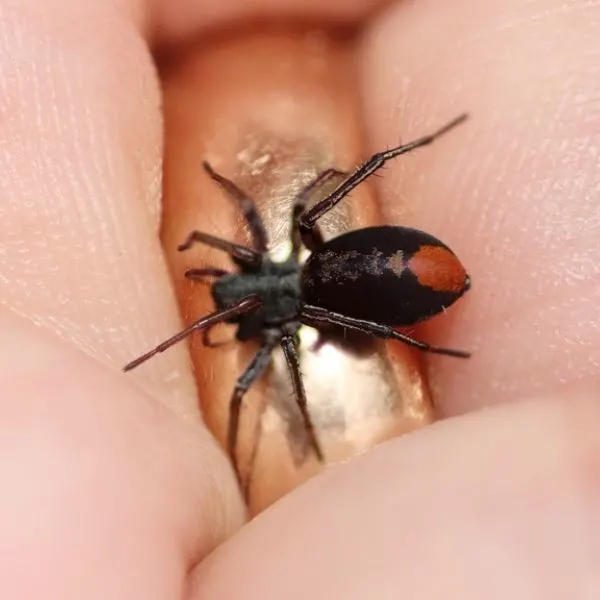
- Experience Level: Beginner to Intermediate
- Family: Corinnidae
- Scientific Name: Castianeira descripta
- Other Names: Ant Mimic Spider
- Adult Size: 0.2 to 0.4 inches
- Lifespan: 1 year
- Average Price Range: N/A
At first glance, the red-spotted ant mimics a spider that looks like a true ant. It has black skin with a bulbous abdomen bearing faint brownish-red markings. It also likes holding its first pair of legs up while walking to appear like a normal six-legged ant with antennae.
The red-spotted ant mimic spider is a hunter spider. It actively chases prey instead of building webs to catch them. So it is likely that its appearance is an adaptation to help it get closer to ants before attacking them.
The glossy black skin and red abdominal markings on this species may also cause inexperienced people to mistake it for a black widow. But both species don’t even belong to the same family. Red-spotted ant mimic spiders also aren’t as venomous.
While this species is aggressive towards prey, it isn’t aggressive towards human beings. Bites are uncommon, but they hurt. You may experience some inflammation and skin reddening, but the effects fade shortly.
Like other hunter spiders, the red-spotted ant mimic spider doesn’t build webs to trap prey. Instead, it spins silk to make protective cocoons for its eggs to live in until they hatch or to build a nest for itself.
Female red-spotted ant mimic spiders are larger than males.
26. Long-Palped Ant Mimic Sac Spider
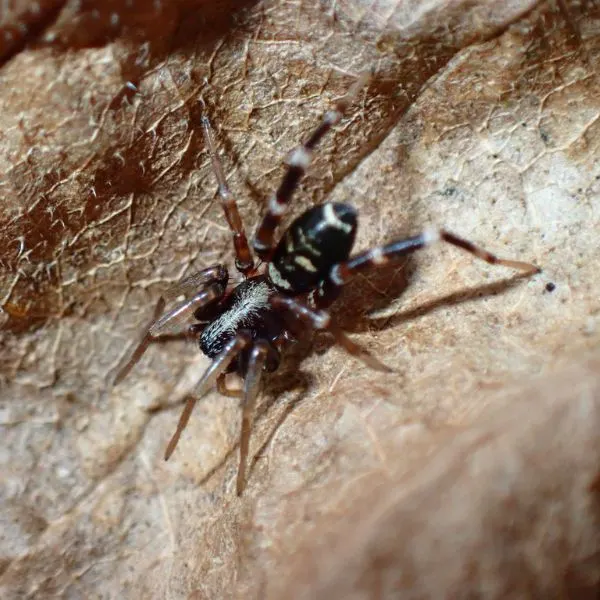
- Experience Level: Beginner to Intermediate
- Family: Corinnidae
- Scientific Name: Castianeira longipalpa
- Other Names: Ant Mimic Spider
- Adult Size: 0.2 to 0.4 inches
- Lifespan: 1 year
- Average Price Range: N/A
Unlike red-spotted ant mimic spiders, long-palped ant mimic sac spiders don’t resemble ants physically. But they share similar ant-like behaviors, such as holding their first pair of legs up in the air like antennae.
Long-palped ant mimic sac spiders have black abdomens bearing several light stripes. The cephalothorax is more variable and may be brown, gray, black, or whitish. Unlike red-spotted spiders, the cephalothorax of this species is larger than the abdomen.
These arachnids walk with two leg pairs in front, one pair on the sides, and another pair at the back. Juveniles have brown front legs, but the part near the carapace is black in adults.
The second-to-the-last pair is typically brownish-black in adults. But the last pair is black with white bands or uniformly black.
Long-palped ant mimic sac spiders spin webs, but only to build nests or wrap their eggs. Like their red-spotted relatives, these arachnids don’t rely on webs to trap prey for them. Instead, they stalk their prey before pouncing.
Members of this species are fast spiders, but they aren’t as aggressive as they seem. They usually run away when threatened by human beings or larger animals. They rarely bite humans, and these bites are relatively mild.
Male long-palped ant mimic sac spiders are about half the size of females. You can find this species in many parts of Missouri and other states across the US.
27. American Nursery Web Spider
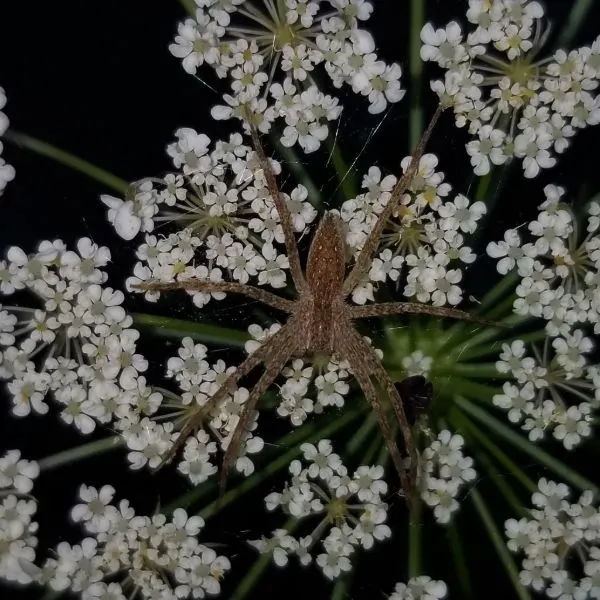
- Experience Level: Beginner to Intermediate
- Family: Pisauridae
- Scientific Name: Pisaurina mira
- Other Names: Nursery Web Spider
- Adult Size: 0.35 to 0.6 inches
- Lifespan: 1 year
- Average Price Range: N/A
American nursery web spiders are often mistaken for fishing or wolf spiders because they look alike. Nursery web and fishing spiders belong to the same family, and they can both walk on water surfaces.
American nursery spiders sometimes dive underwater to escape predators. Like true hunters, these American nursery web spiders stalk their prey and seize them with their chelicerae instead of employing webs.
These arachnids inject their prey with venom before feasting on it. Their typical diet consists of mosquitoes, flies, and other arthropods.
The venom of this spider is not toxic enough to harm you. Its sting will probably hurt, but you won’t get any serious reaction. While you might experience more serious symptoms if you’re allergic to spider venom, you’ll be fine.
You can find these interesting spiders in Missouri’s tall grasslands and areas with low shrubs. Two forms of this species exist. The first has a broad, deep brown mid-stripe on an otherwise tan body. This stripe has small light markings along its borders.
The legs of the first form are medium length, in contrast with the slightly longer legs seen in the second variant. Also, the second form is darker and has cream markings running down its abdomen.
These spiders don’t build webs to trap prey. Instead, they spin silk cocoons for their young, which they carry around for a while. When the hatching season draws near, they place these eggs in a shelter and guard them until they hatch.
A particularly fascinating spider species, males tend to tie females up in silk webs while mating. This action is to prevent females from consuming them after mating.
There are other species of nursery web spiders in Missouri. However, these spiders are often difficult to differentiate at the species level.
28. Bold Jumping Spider

- Experience Level: Beginner to Intermediate
- Family: Salticidae
- Scientific Name: Phidippus audax
- Other Names: Daring Jumping Spider, White-spotted Jumper
- Adult Size: 0.25 to 0.75 inches
- Lifespan: 1 year
- Average Price Range: N/A
The “audax” in this species’ name probably stands for audacious. The bold jumper belongs to a family of spiders that use silk lines to jump. It can leap up to 50 times its body length, more than many jumping spiders can afford.
The bold jumper is a hairy black spider with 3 spots on the back of its abdomen. The spots are yellowish in juveniles, but they fade into white in adults. That’s why they are also called white-spotted spiders.
This arachnid has shorter legs than most spiders. It uses its strong back legs for jumping by altering the pressure in them. Like many spiders, female bold jumpers are larger than males. They also have abdomens bigger than their cephalothorax.
It is easy to mistake the bold jumper for other jumping species. The best way to identify this species is to examine its fangs, which are typically greenish.
This bold jumper is a hunter spider, so it goes after prey instead of spinning webs to catch them. When it spins webs, the web is often a single silk line used as an anchor while jumping. It also sometimes builds nests for itself.
Bold jumpers are shy around people and often run when threatened. However, they will bite when given no choice. The bite is usually harmless, but it can cause pain and inflammation. Allergic people may experience more uncomfortable symptoms.
29. Brilliant Jumping Spider

- Experience Level: Beginner to Intermediate
- Family: Salticidae
- Scientific Name: Phidippus clarus
- Other Names: Jumping Spider, Brilliant Jumper
- Adult Size: 0.125 to 0.75 inches
- Lifespan: 1 year
- Average Price Range: N/A
The brilliant jumping spider is closely related to the daring jumping spider. Most jumping spiders in Missouri belong to this species, and you can find them all over the state.
Like the bold jumper, the brilliant jumping spider is a hunter. So it doesn’t build webs to catch its prey. Instead, you will often find this spider on flowers or plant tops waiting for prey to come by. It consumes plenty of insects, but it also eats spiders it can subdue.
The brilliant jumping spider is beautiful. It has a hairy black body and white to light gray pedipalps. In addition, the black legs have white or brown bands.
The abdomen of this species is different from the rest of its body. The abdomen is reddish-orange or brown with a black marking running along its back. It also has a white transverse band where it joins with the cephalothorax.
The cephalothorax of this spider species is often bigger than the abdomen in males. However, female brilliant jumping spiders are generally bigger than males.
This arachnid is medically insignificant, so its bite cannot harm you.
30. Trapdoor Spider
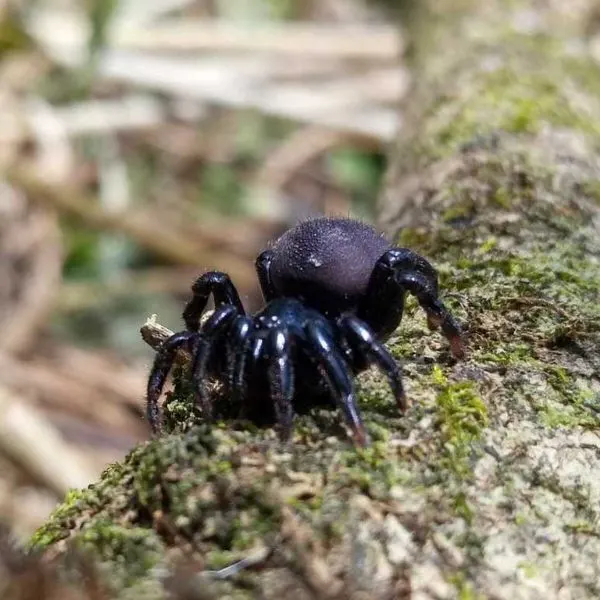
- Experience Level: Beginner to Intermediate
- Family: Halonoproctidae
- Scientific Name: Ctenizidae
- Other Names: Mygalomorph Spider
- Adult Size: Up to 1.6 inches
- Lifespan: 5 to 20 years
- Average Price Range: N/A
Trapdoor spiders are a unique genus of spiders in Missouri that live in underground tunnels. They don’t build conventional nests like other spiders.
Instead, they spin trapdoors of silk mixed with debris over the entrance of their tunnels. These trapdoors have hinges.
The body of this spider is typically chocolate brown or reddish-brown. The color is often uniform, and the carapace is hard with a glossy appearance. It is disc-shaped and looks like a glove with 8 fingers if you look at it from the top.
Trapdoor spiders are swift predators who go after their prey. They chase, catch, then subdue their prey with venom before eating. They have 2 big fangs, which they use to seize prey during a hunt.
These arachnids are somewhat shy around people. They often run when they feel threatened, so bites are rare. If you get bitten, the venom is harmless. The pain will also pass quickly.
31. Spitting Spider

- Experience Level: Beginner to Intermediate
- Family: Scytodidae
- Scientific Name: Scytodes thoracica
- Other Names: Spitting Spider
- Adult Size: 0.15 to 0.25 inches
- Lifespan: Up to 5 years
- Average Price Range: N/A
The spitting spider has a consistent pattern on its cephalothorax, abdomen, and legs. The ground color is light brown with several spots and markings of dark brown. On the legs, the dark spots are replaced with dark bands.
You can easily identify this spider by its distinct look. The species’ unique color pattern is the primary way to identify it. In addition, the cephalothorax of this spider is larger than the abdomen, which is unusual among spiders.
The cephalothorax and abdomen also have similar dome shapes. Finally, this species has only 6 eyes compared to other spider species with 8 eyes.
The main distinguishing feature of this species is that it can shoot venomous silk threads out of its silk gland. This silk thread immobilizes any insect it targets, removing the need to use nests or grab the prey first.
The venomous silk this spider spits is liquid, but it turns solid once it contacts air. This arachnid sprays prey until the animal is completely paralyzed before feasting on it.
Fortunately, the spitting spider is harmless to humans. It reserves its venomous silk threads for small prey and does not attack potential predators. It also can’t puncture human skin with its bite, and the toxic silk doesn’t cause any reaction.
Like most spiders in Missouri and the US, male spitting spiders are smaller than females. You can find these arachnids in cool, dry areas in Missouri.
32. Broad-faced Sac Spider

- Experience Level: Beginner to Intermediate
- Family: Trachelidae
- Scientific Name: Trachelas tranquillus
- Other Names: Hunter Spider
- Adult Size: Up to 0.75 inches
- Lifespan: 1 year
- Average Price Range: N/A
The broad-faced sac spider is a plain spider without patterns. It has a smooth tan or gray abdomen and a dark reddish-brown cephalothorax. Most of this spider’s legs are pale, but the first two pairs are reddish-brown.
You’ll often find this spider outdoors, not inside homes or buildings. However, many migrate indoors in colder seasons. The broad-faced spider can inflict painful stings on you due to its large fangs, but its venom will not harm you.
Like many hunter spiders, this species does not use webs to catch prey. Instead, it seizes them and injects them with venom before eating.
This arachnid is nocturnal, so it usually hunts insects and other arthropods at night.
The most peculiar feature of this spider is its web-spinning habit. It does not spin conventional nests for itself. Instead, it spins a sac-like cocoon in which it rests during the daytime. This behavior is why it is called a sac spider.
You can find this arachnid in many parts of Missouri. When indoors, it prefers to stay in corners, windowsills, or wall cracks.
33. Golden Jumping Spider
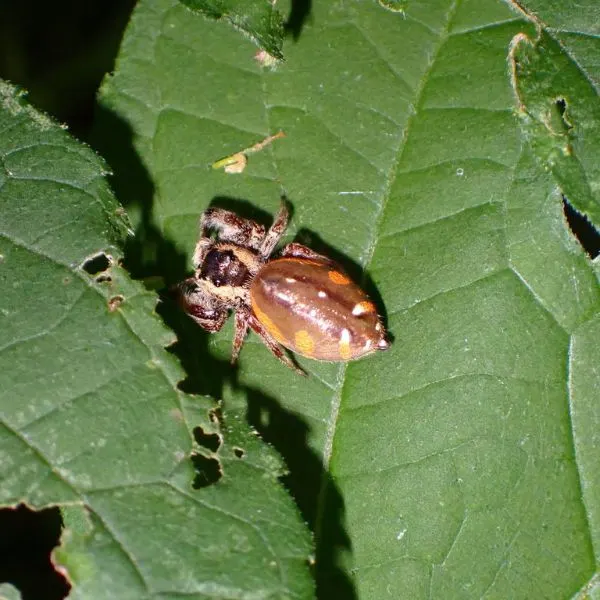
- Experience Level: Beginner to Intermediate
- Family: Salticidae
- Scientific Name: Paraphidippus aurantius
- Other Names: Emerald Jumping Spider
- Adult Size: 0.28 to 0.47 inches
- Lifespan: 1 year
- Average Price Range: N/A
The golden jumping spider is one of the most beautiful spiders in Missouri. This spider is covered with brown or golden hair, but the middle of the abdomen and carapace are metallic green. You can easily see sunlight bounce off the green parts.
An orangish-brown line encircles the edge of the abdomen, and the green region has several pairs of black spots in the middle. Like most spiders, this one has 8 eyes. Most of these eyes are in front, while 2 are at the sides of the carapace.
The golden jumping spider can leap to impressive heights. It does this with the aid of a silk thread anchored to the surface it is jumping from. In case anything goes wrong with its jump, this silk thread acts as a safety line that protects it.
Besides spinning this single silk thread, the only other web it spins are cocoons for its eggs. They are hunter spiders, so they don’t use nets to catch prey. They pursue them instead, immobilizing the prey with their venom.
This stunning spider is not aggressive towards people, but it is not scared of them either. If you threaten or corner it, it is likely to sting you. The sting is painful, but it does not cause any real harm.
34. Tan Jumping Spider

- Experience Level: Beginner to Intermediate
- Family: Salticidae
- Scientific Name: Platycryptus undatus
- Other Names: Jumping Spider
- Adult Size: 0.3 to 0.5 inches
- Lifespan: 1 year
- Average Price Range: N/A
The tan jumping spider is generally black and completely covered in short, whitish-gray hairs. It also has a light pattern running along the middle of its back. The middle strip in this pattern is black and gray, while the sides are tan and cream or white.
Female tan jumping spiders are slightly larger than males. Males are generally lighter in color and have longer and thicker front legs. If you look closely at males, you’ll also observe an orange band under their front eyes.
Tan jumping spiders are not aggressive, but they aren’t shy either. They rarely run away from humans, so you can hold them in your hands without issue. Be careful not to squeeze them, though. They may inflict a painful bite if they feel threatened.
These arachnids actively hunt prey and use venom to immobilize them. Since they are jumping hunter spiders, they do not rely on spinning webs to catch prey.
Tan jumping spiders mostly spin cocoons to house their eggs. They also spin silk lines they use as tethers when jumping. If the jump fails, they use this silk line to anchor themselves instead of landing badly.
You can find tan jumping spiders in Missouri and most states in the eastern part of the US.
35. Marbled Orb-weaver
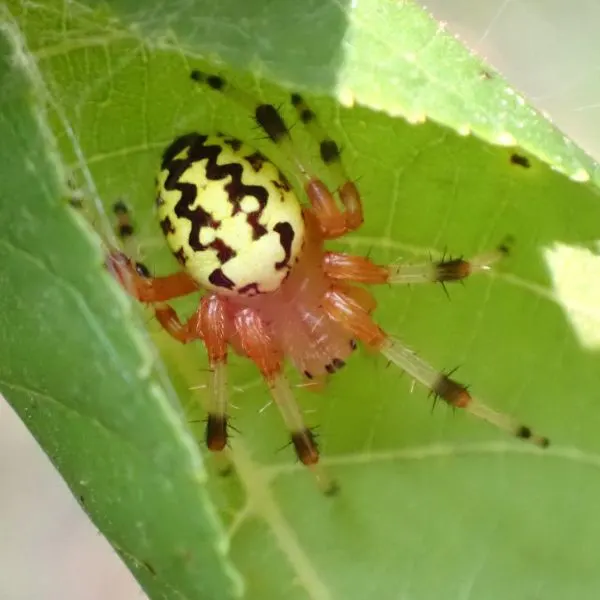
- Experience Level: Beginner to Intermediate
- Family: Araneidae
- Scientific Name: Araneus marmoreus
- Other Names: Pumpkin Spider
- Adult Size: Up to 1 inch
- Lifespan: 1 year
- Average Price Range: N/A
Marbled orb-weavers are colorful spiders with massive, round abdomens. The orange abdomen typically bears orange-brown markings that form a bilaterally symmetrical pattern. They are called pumpkin spiders because their rounded abdomens resemble pumpkins.
These arachnids look like regular bugs when viewed from above because of their abdomens. If you observe them closely, you’ll notice several tiny spines covering their legs.
Marbled orb-weavers are highly variable in color, so you may find some that look different from what is described here. Their bodies may be white, tan, gray, or yellow and bear black or purple spotting.
You can find marbled orb-weavers in moist forests, especially those in coastal areas. They spin vertical webs in shrubs or between tree branches or trunks to catch insects. When the web traps an insect, they receive a signal and rush down to eat the prey.
These arachnids are not harmful to humans. They usually run when threatened but may bite on rare occasions. This only happens if they are cornered or squashed against human skin.
36. Common House Spider
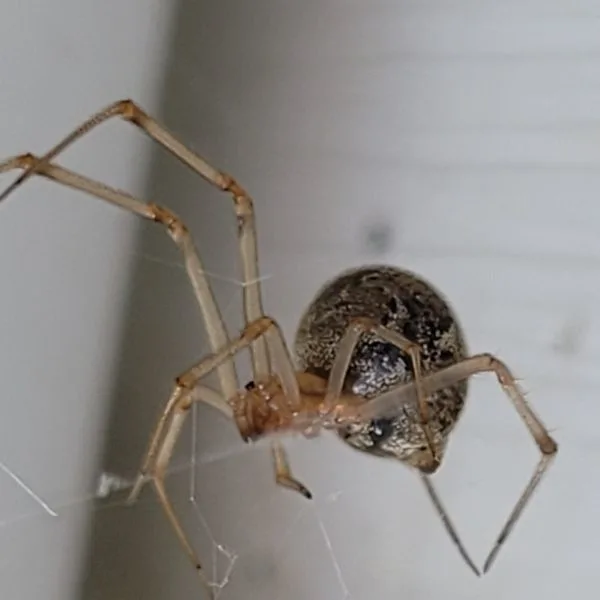
- Experience Level: Beginner to Intermediate
- Family: Theridiidae
- Scientific Name: Parasteatoda tepidariorum
- Other Names: American House Spider, House Spider
- Adult Size: 0.125 to 0.75 inches
- Lifespan: 1 to 7 years
- Average Price Range: N/A
Common house spiders are arguably the most encountered spiders in Missouri homes. They have a tan or gray body with a small cephalothorax and a large, round abdomen. The abdomen is taller than it is wide or long.
The abdomen also has whitish markings on it at several points. The tan legs also have dark brown rings at the joints. Like other spiders, female common house spiders are typically larger than males.
Female common house spiders spend more time out in the open than males. You’re most likely to encounter males during mating periods in the web of female spiders.
Although this species belongs to the same family as black widows, it is not harmful to people. It spins webs just as tangled as black widows, and it is generally non-aggressive. You have nothing to fear if you encounter one.
This carnivorous arachnid feeds on several arthropods, such as flies, mosquitoes, and roaches. Although its webs can be unpleasant to look at, it uses them to trap insects it’ll feed on. This makes it an effective biological pest control agent.
Common house spiders live longer than most spiders in Missouri. This is because the warmth inside homes prevents them from freezing to death like other species that live outdoors. Staying indoors also reduces the number of predators targeting it.
37. Triangulate Combfoot
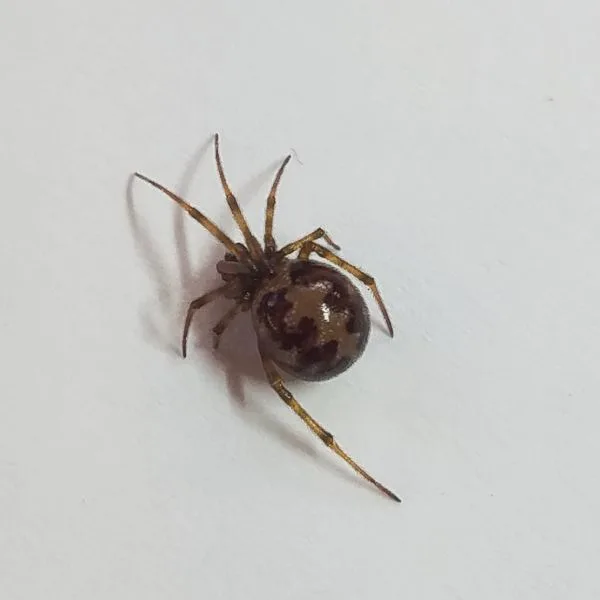
- Experience Level: Beginner to Intermediate
- Family: Theridiidae
- Scientific Name: Steatoda triangulosa
- Other Names: Triangulate Cobweb Spider, Triangulate Bug Spider
- Adult Size: Up to 0.25 inches
- Lifespan: 1 to 3 years
- Average Price Range: N/A
The triangulate combfoot is a cobweb spider in the same family as black widows. The abdomen is black or dark brown with light brown triangular markings in the middle. The carapace is dark brown, while the legs have alternating light and dark brown bands.
The triangulate cobweb spider is a carnivorous arachnid. This arachnid builds strong, intricate webs to trap prey like flies and ants. It also eats venomous spider species like the brown recluse.
Although it belongs to a family of highly venomous spiders, the triangulate cobweb spider is harmless to humans.
Like most spiders in Missouri, female triangulate combfoots are larger than males. You can find these spiders throughout Missouri and most of the United States.
38. Eastern Parson Spider
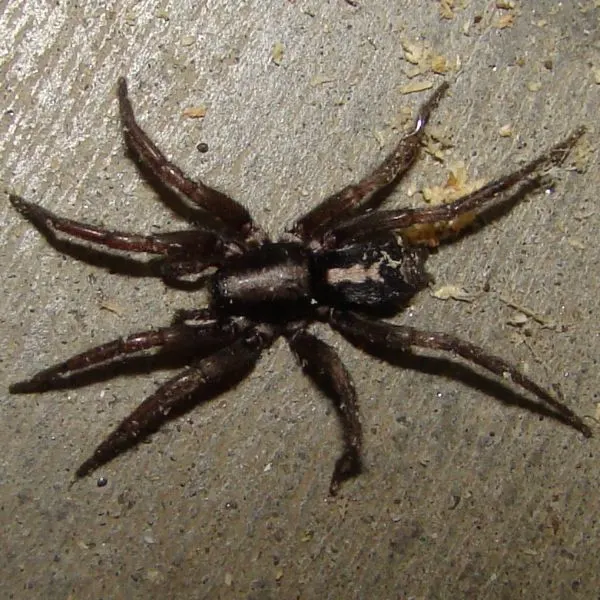
- Experience Level: Beginner to Intermediate
- Family: Gnaphosidae
- Scientific Name: Herpyllus ecclesiasticus
- Other Names: Parson Spider
- Adult Size: 0.3 to 0.8 inches
- Lifespan: 1 to 2 years
- Average Price Range: N/A
The eastern parson spider is a black to dark brown hunter spider found in Missouri. Originally native to the eastern part of the US, this spider has now fully established itself in every state in the US.
You can find this arachnid in the woods, where it hides under rocks and rotting logs. Sometimes, this spider also wanders into people’s homes. The spider is nocturnal, so you may not notice its presence in your home.
This species is aggressive. While it doesn’t attack humans unprovoked, it will quickly strike if threatened and cornered. The pain from this arachnid’s bite is intense, but it doesn’t cause any serious injury.
The eastern parson spider is carnivorous, so it feeds primarily on insects and other small prey. Like other hunter spiders, it doesn’t trap prey in webs. Instead, it stalks prey and immobilizes them with its venom.
This arachnid only spins webs to wrap its eggs. The spider may stay with its eggs as long as it can before they hatch.
This spider has two pikes and a light gray marking at the end and top of its abdomen, respectively. The light gray marking resembles a neckband catholic clergymen used to wear. That’s what it is called a “parson” or “ecclesiasticus” spider.
The body of the eastern parson spider is covered with hairs, which makes it appear thick and intimidating. Individuals also generally have reddish-brown legs.
Like most spiders, females of this species are larger than males.
39. Speckled Wolf Spider
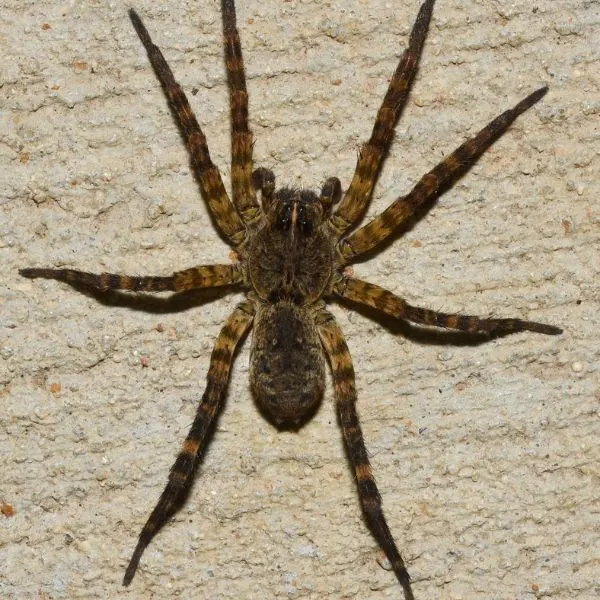
- Experience Level: Beginner to Intermediate
- Family: Lycosidae
- Scientific Name: Tigrosa aspersa
- Other Names: Wolf Spider, Hunter Spider
- Adult Size: 0.5 to 0.8 inches
- Lifespan: 1 year
- Average Price Range: N/A
The speckled wolf spider is one of the most common wolf spiders in Missouri. It is mostly black, with several regions of grayish-brown on its body and legs. The middle of this hairy arachnid’s carapace also has a yellowish-brown line running between the eyes.
Like other wolf spiders, female speckled wolf spiders have incredible maternal instincts. They carry their eggs around in spinnerets, protecting them until they hatch. If threatened and made to drop the eggs, they go back for them once the dust settles.
Female speckled wolf spiders carry their newly hatched young on their abdomen until the young spiders can care for themselves.
Speckled wolf spiders are hunter spiders, so they don’t build webs to catch their prey. Instead, they hunt down their prey and inject it with venom. Once the prey is immobilized, they start digesting it immediately.
You have nothing to fear if you encounter a speckled wolf spider. This arachnid is not aggressive towards people, so bites are rare. If you get bitten, you might experience pain. But the venom is not toxic enough to harm you.
40. Bowl and Doily Spider

- Experience Level: Beginner to Intermediate
- Family: Linyphiidae
- Scientific Name: Frontinella pyramitela
- Other Names: Sheet-weavers
- Adult Size: Up to 0.15 inches
- Lifespan: 1 year
- Average Price Range: N/A
Bowl and doily spiders are sheet-weavers that spin horizontal sheet-like webs under a bowl or inverted dome-shaped web. This is where their name comes from. A doily is a flat piece of cloth usually placed under a bowl.
Like other sheet-weavers, the brown and doily spider relies on webs to trap prey for it. This web isn’t sticky, but the bowl and doily web design help it make up for this shortcoming. The webs are often large and spread from one twig to another.
The spider often hangs around on the lower sheet, waiting for an insect or arthropod to enter the bowl above it. As soon as prey enters, this arachnid stings the prey from under to paralyze it. Then the spider moves into the web to begin eating.
The cephalothorax of this species is reddish-brown and glossy. The abdomen also appears glossy, but it is usually black or dark brown on top with white markings on the side. These markings curve towards the underside and fade into yellow or black.
Bowl and doily spiders have minute bodies and long, hairy legs. Like most spider species, females are larger than males.
This species’ venom is not medically significant, so you should not panic if you encounter one.
41. Wetland Giant Wolf Spider
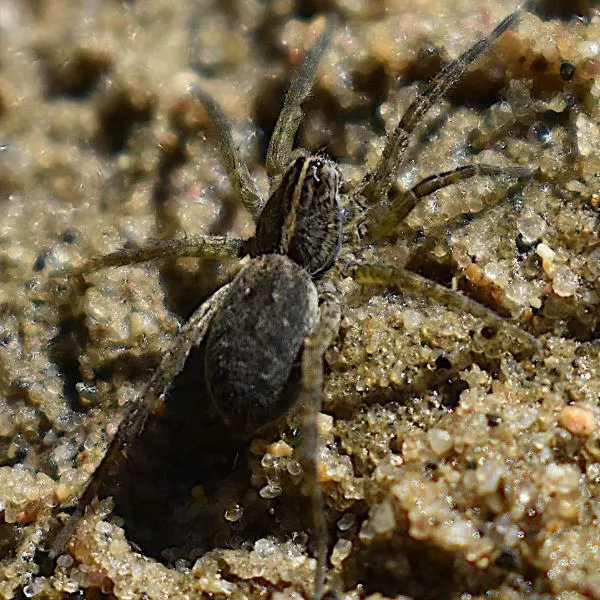
- Experience Level: Beginner to Intermediate
- Family: Lycosidae
- Scientific Name: Tigrosa helluo
- Other Names: Wolf Spider
- Adult Size: 0.39 to 1.22 inches
- Lifespan: 1 to 2 years
- Average Price Range: N/A
The wetland giant wolf spider resembles other wolf spiders in Missouri. Like the others, it is a hunter spider that doesn’t build webs to catch prey. It hunts alone and takes pride in stalking prey before attacking.
While its venom is potent against insects and other arthropods it consumes, the venom is harmless to humans. The spider is also usually non-aggressive towards people, so you have nothing to fear. Females protecting their young can be fierce, but they won’t attack you unless threatened.
Female giant wolf spiders carry their eggs around in spinnerets until they hatch. After hatching, these immature spiders ride the mother’s abdomen until they mature enough to care for themselves.
Wetland giant wolf spiders are a mix of brown and tan or grayish-brown. The hairy carapace has a narrow, tan middle strip flanked by brown bands. The abdomen is similar, but you can distinguish this species by the brown arrowhead in the middle of its much wider tan mid-strip.
42. Striped Lynx Spider
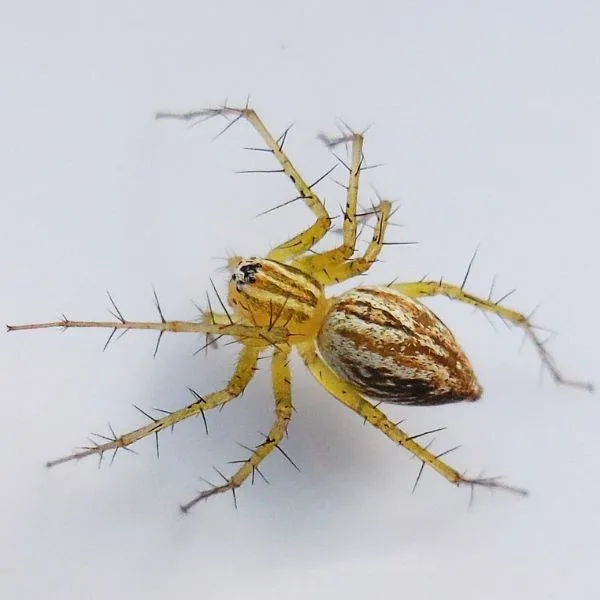
- Experience Level: Beginner to Intermediate
- Family: Oxyopidae
- Scientific Name: Oxyopes salticus
- Other Names: Lynx Spider, Grass Lynx Spider
- Adult Size: 0.16 to 0.24 inches
- Lifespan: 1 year
- Average Price Range: N/A
The striped lynx spider is a hunter species that pursues its prey instead of trapping them with webs. Like many spiders in Missouri, it favors well-planted areas. So you can find it in prairies and places abundant in leafy vegetation.
This diurnal hunter tracks prey during the day when it’s most active. A large part of its diet is made up of crawling insects it injected with venom before consuming. Fortunately, this venom is ineffective against people.
Stripe lynx spiders are safe to be around, and they scarcely bite except if threatened or squashed. If one bites you, you might experience some pain and discomfort. But this quickly goes away.
You can identify this species by its large, diamond cardiac mark. The abdomen and carapace have a similar bilaterally symmetrical pattern of deep brown, goldish, and off-white stripes. The legs are translucent gold or yellow and spiny.
43. Dimorphic Jumping Spider
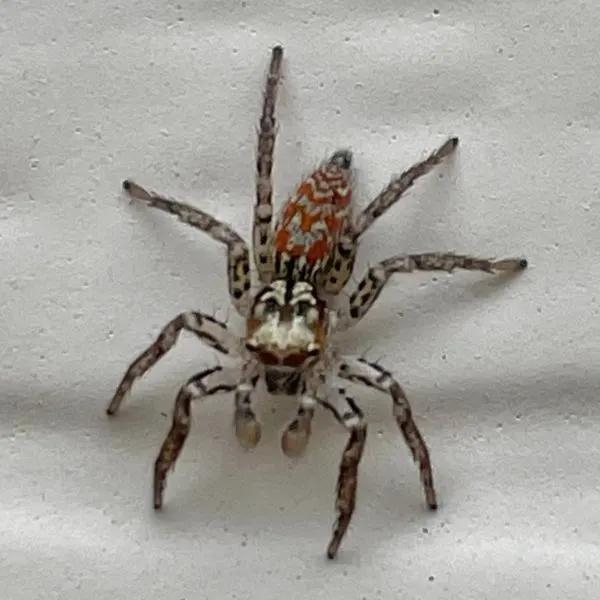
- Experience Level: Beginner to Intermediate
- Family: Salticidae
- Scientific Name: Maevia inclemens
- Other Names: Jumping Spider
- Adult Size: 0.2 to 0.3 inches
- Lifespan: 1 year
- Average Price Range: N/A
Dimorphic Jumping spiders are unique because males in this species occur in two visually distinct forms. This type of dimorphism is uncommon among animals, not just spiders. The main distinguishing feature between both forms is the presence of tufts.
One male form has three black tufts arranged on its head, so it’s called the tufted morph—or black morph since its body is black. Unlike the tufted male, the second lacks tufts. The second form is called the gray morph because it is typically gray with white stripes.
Females don’t show the dimorphism of males. They have brown bodies with red markings on their legs and abdomens.
Like other jumping spiders, this species can jump to great heights with the help of a silk thread. This silk line acts as a safety line to protect it during dangerous jumps. But it does not spin webs to catch prey.
Dimorphic Jumping spiders are good predators. They have two large frontal eyes that help them see clearly and three side pairs they use to detect motion in their surroundings. Instead of using webs, these arachnids stalk prey, immobilize, then eat.
Dimorphic Jumping spiders are effective at using venom to subdue prey, but they are not a threat to you. They avoid confrontation, but you’re unlikely to experience any serious reactions even if one bites you.
You can find these fascinating spiders in Missouri and many parts of the US.
44. White-jawed Jumping Spider
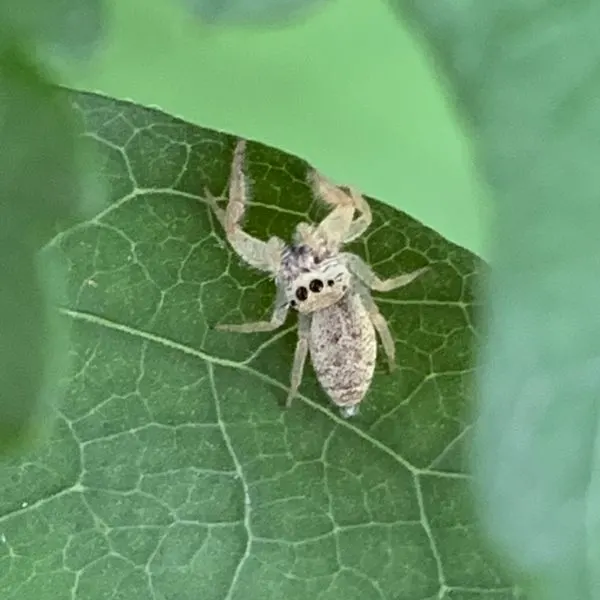
- Experience Level: Beginner to Intermediate
- Family: Salticidae
- Scientific Name: Hentzia mitrata
- Other Names: Crowned Hentzian Jumping Spider, Jumping Spider
- Adult Size: Up to 0.6 inches
- Lifespan: 1 year
- Average Price Range: N/A
These arachnids are nocturnal, so you’ll hardly see them during the day. They spend most of their time in tree canopies, but they often range outside their habitats in search of prey. As carnivores, insects and other small organisms are the bulk of their diet.
The white-jawed jumping spider has hairy legs and a distinct copper body, which is unusual among jumping spiders. But it is similar to its jumping relatives in other areas. For example, it can jump, and it is good at catching prey without web traps.
This arachnid species only spins webs to protect its eggs or use it as safety lines when it makes daring jumps.
You have nothing to worry about if you encounter this spider. While it aggressively hunts prey, it does not bite without provocation. The venom is also not medically significant, so any symptoms you develop will vanish quickly.
45. Star-bellied Orb-weaver
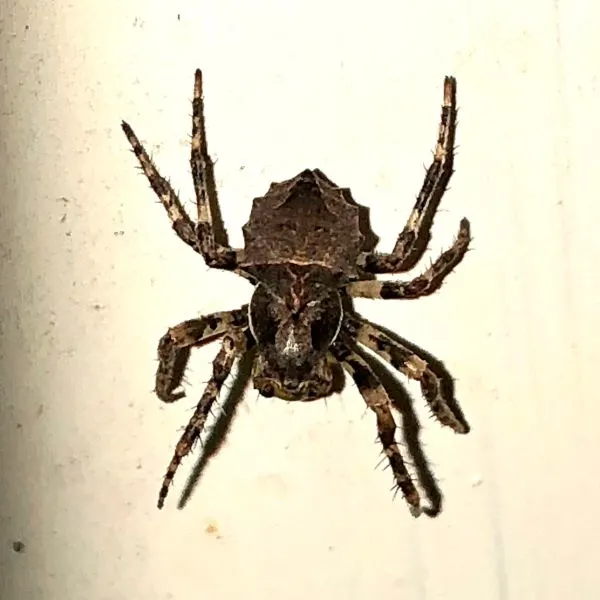
- Experience Level: Beginner to Intermediate
- Family: Araneidae
- Scientific Name: Acanthepeira stellata
- Other Names: Starbellied Spider
- Adult Size: 0.2 to 0.6 inches
- Lifespan: 1 year
- Average Price Range: N/A
Star-bellied orb-weavers differ from other orb-weavers due to their distinct abdomens. These spiders have large abdomens with spiky surfaces, giving the belly a star-like appearance. In addition, their legs have several spiny projections.
This species is typically brown or orange. However, you may come across some star-bellied orb-weavers that are more brownish-gray in color. It typically has multiple color shades, but this is most visible in the alternating light and dark bands on its feet.
Females are generally larger than males. Their abdomens are also disproportionately larger than their bodies compared to males.
These spiders’ primary food source is the prey their webs trap. Like other web-spinning spiders, star-bellied orb-weavers have vibration sensors that let them know when their webs have caught an insect. These spiders then neutralize the insect with their venom before eating it.
The venom made by star-bellied orb-weavers isn’t potent enough to harm you. But bites from these spiders hurt, and the pain may last for a while. Thankfully, bites are rare.
Star-bellied orb-weavers have a habit of playing dead when threatened. For example, if their web catches an animal they can’t overpower, they sometimes drop to the floor and curl as if dead. They only get up when the threat has passed.
These arachnids are primarily active at night. You can find them all over Missouri and throughout the United States.
46. Cat-faced Orbweaver
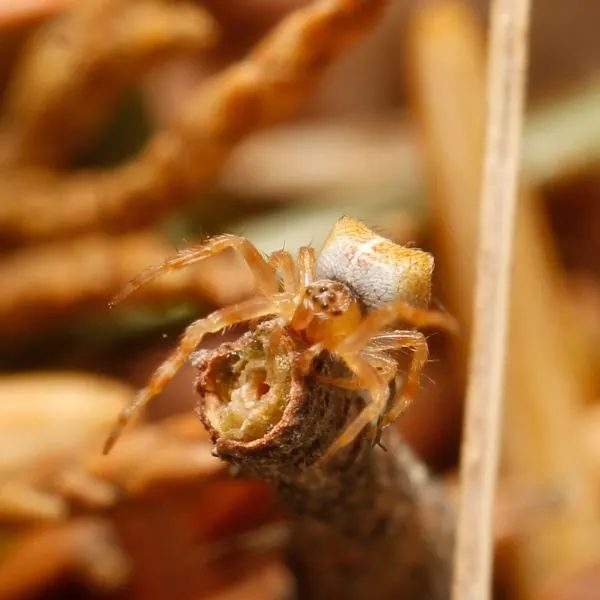
- Experience Level: Beginner to Intermediate
- Family: Araneidae
- Scientific Name: Araneus gemmoides
- Other Names: Jewel Spider, Cat-faced orb-weaver
- Adult Size: 0.2 to 1 inches
- Lifespan: 1 year
- Average Price Range: N/A
Cat-faced spiders are a rather peculiar spider species with massive abdomens. They are covered in whitish spines, and their bodies range from white and dark brown to orange. When you observe this arachnid from the front, it slightly resembles a cat’s face.
The other name of the cat-faced spider comes from the shape of its abdomen. The abdomen has defined angles that cause it to resemble a jewel.
This orb-weaver is carnivorous. Therefore, it feeds primarily on insects and smaller prey. It traps prey in its web before immobilizing them with its venom and eating.
Cat-faced spiders are harmless to human beings. They typically run when threatened, so bites are extremely rare. Even the most extreme bite reactions are mild in most people. However, you may have more serious reactions if you are allergic to spider venom.
Bites from these spiders are not medically significant. But see a doctor if you experience strange symptoms.
47. Shamrock Spider
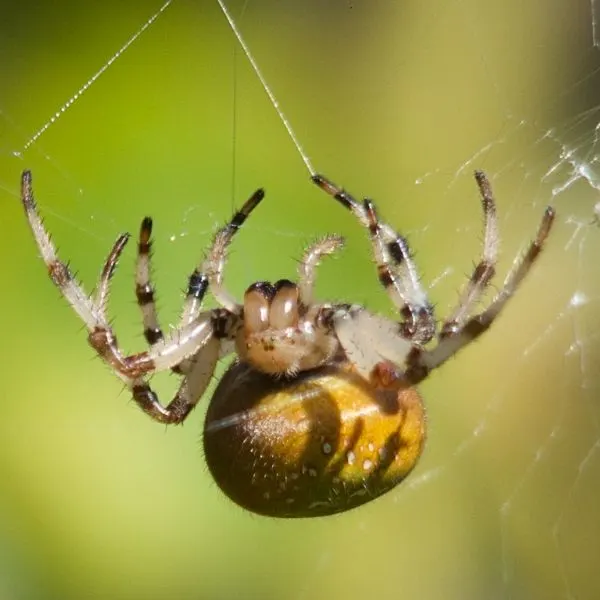
- Experience Level: Beginner to Intermediate
- Family: Araneidae
- Scientific Name: Araneus trifolium
- Other Names: Orb-weaver
- Adult Size: Up to 0.75 inches
- Lifespan: 1 year
- Average Price Range: N/A
Shamrock spiders are beautiful arachnids with hairy bodies. You can identify them by the presence of alternating white and dark brown bands on each leg, a hairy whitish abdomen, and a dark brown cephalothorax.
Although shamrock spiders vary in color, most are a mix of white and beige or dark brown. You may encounter some with greenish, orange, reddish, yellowish, and even brown abdomens. All shamrock species typically possess white rings on each leg.
Be careful around these spiders. While they rarely bite, their bites can be painful when they choose to. These bites cause a slight skin reaction. Fortunately, their venom is harmless, and the symptoms fade quickly.
Their venom is more effective on insects like flies and moths. Shamrock spiders are carnivorous orb-weavers, so they spin webs to trap insect prey.
Shamrock spider webs are sometimes as wide as 2 feet. These arachnids often dismantle their webs and rebuild them every evening to trap prey.
48. False Black Widow
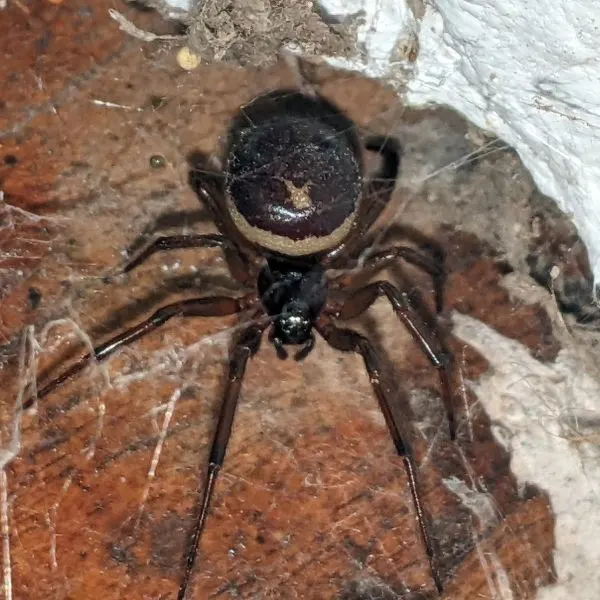
- Experience Level: Beginner to Intermediate
- Family: Theridiidae
- Scientific Name: Steatoda grossa
- Other Names: Cupboard Spider
- Adult Size: 0.25 to 0.4 inches
- Lifespan: 1 to 6 years
- Average Price Range: N/A
Originally imported from Europe, the false black widow has grown to become a widespread species in the United States. It is related to the more well-known black widow spiders and closely resembles them.
False black widows generally have dark, round abdomens. They are shaped like black widows, but their skin is closer to dark purple than black. At first glance, it may be challenging to tell them apart from true black widows.
But you can differentiate both spiders if you examine them closely. Unlike true black widows, false black widows do not have the characteristic red hourglass shape on their abdomens.
The bite of this spider can be severe. So if you get bitten, it will hurt a lot. You may also experience discomfort and blistering. But these effects are not life-threatening. The false black widow’s venom is not as potent as a true black widow’s.
False black widows are shy spiders that avoid open spaces and human contact. They typically run when they feel threatened, minimizing bite incidences.
While these spiders often live in people’s homes, they generally restrict themselves to crevices and corners in the home. When your skin presses against this spider or you touch it when it is holed into a corner, it is likely to bite you.
False black widows are carnivorous arachnids. So they feed on several insect and spider species, including the more venomous true black widows.
49. Rabbit Hutch Spider

- Experience Level: Beginner to Intermediate
- Family: Theridiidae
- Scientific Name: Steatoda bipunctata
- Other Names: False Black Widow
- Adult Size: 0.31 inches
- Lifespan: 1 to 6 years
- Average Price Range: N/A
Like black widows and false black widows, the rabbit hutch is a cobweb spider. It has a black to dark brown body and a light mid-stripe on the back of its abdomen. This stripe curves around the anterior part of the abdomen before extending backward in a straight line.
Many inexperienced people mistake black rabbit hutch spiders for true black widows. But rabbit hutch spiders don’t have an hourglass-shaped marking on their abdomen. Their body also lacks the glossy appearance of true black widows.
Although they belong to the same family as true black widows, they are not as venomous. Human bites are rare. Bites do not cause any serious injury, and the effect wears off quickly.
Rabbit hutch spiders are carnivorous. So they feed on various insects to derive important nutrients.
50. Zebra Spider
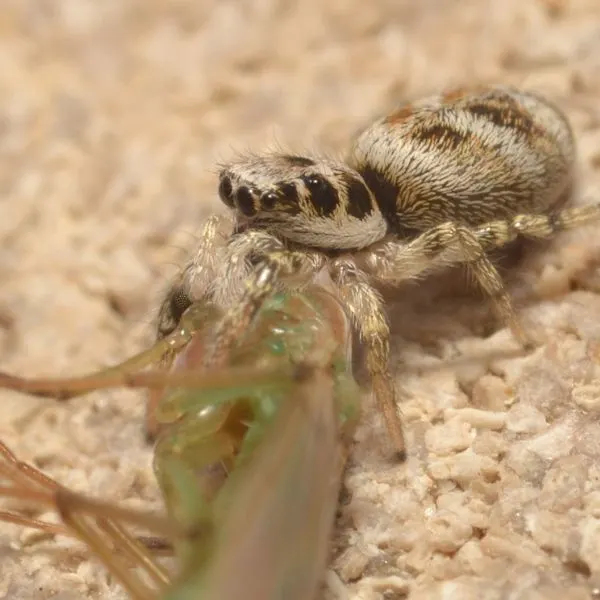
- Experience Level: Beginner to Intermediate
- Family: Salticidae
- Scientific Name: Salticus scenicus
- Other Names: Jumping Spider
- Adult Size: Up to 0.25 inches
- Lifespan: 1 year
- Average Price Range: N/A
Zebra spiders are called so because they have similar stripe patterns to zebras. These jumping spiders have a black ground color broken with several white stripes. If you look closely, you’ll notice these white stripes are simply long patches of tiny white hairs.
You can find black and white patterned zebra spiders in many parts of Missouri and the United States. However, some seem to have a dark brown base color instead of black.
Zebra spiders are predatory arachnids. Unlike regular web weavers, these spiders don’t catch their prey using webs. Instead, they actively hunt and attack prey.
Like most spiders, this species has 8 eyes. Its abdomen is slightly larger than the cephalothorax. It also has legs that are shorter than those of most spider species.
This arachnid’s venom is not medically significant. So a bite from this spider will not cause any health problems.
51. Arabesque Orbweaver

- Experience Level: Beginner to Intermediate
- Family: Araneidae
- Scientific Name: Neoscona arabesca
- Other Names: Arabesque Orb-weaver
- Adult Size: 0.18 to 0.3 inches
- Lifespan: 1 year
- Average Price Range: N/A
Arabesque orb-weavers are hairy orb-weavers with beautiful, swirling patterns on their abdomens. These markings are most visible after the arachnid sheds its skin. Sadly, many lose this striking pattern with age and become easy to mistake for other orb-weaving species.
The abdomen of this species is larger than its cephalothorax, and its legs have several tiny black spines. The legs have alternating dark and light stripes, but the body color varies with the individual. You may find arabesque orb-weavers with brown, gray, orange, red, or green bodies.
Like most orb-weavers, the arabesque orb-weaver spins vertical webs to trap flying insects like mosquitoes and flies. Females spend more time on the web, while males usually scour the ground for small prey.
This species has a painful sting comparable to a bee’s but causes no damage. Since this spider is not aggressive towards humans, bites are rare. You’re only likely to get bitten if you squash this spider or press your skin against it.
Female arabesque orb-weavers are larger than males. Besides this, you can also distinguish them by their abdomen-to-body ratio. Females have large abdomens and small cephalothoraxes, while males have similar-sized abdomens and cephalothoraxes.
You can find this arachnid species throughout Missouri and most of the United States.
52. White Micrathena
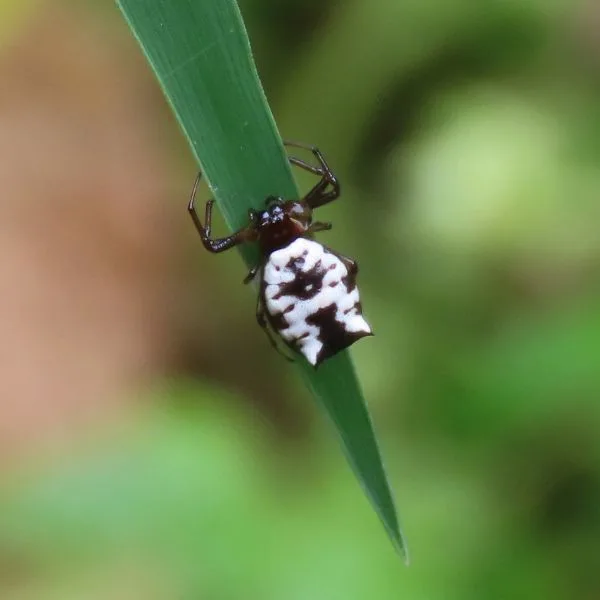
- Experience Level: Beginner to Intermediate
- Family: Araneidae
- Scientific Name: Micrathena mitrata
- Other Names: Orb-weaver
- Adult Size: Up to 0.2 inches
- Lifespan: 1 year
- Average Price Range: N/A
The white micrathena is an orb-weaver with a large whitish abdomen bearing several black, brown, or reddish-brown markings. The end of the abdomen has four spiky protrusions with dark brown or black tips. A black line vertically separates both pairs.
The underside of the white micrathena is usually black with white spots, while the cephalothorax and legs are dark brown and glossy. This species resembles its close relative, the spined micrathena.
The white micrathena weaves horizontal webs instead of the vertical forms most orb-weavers spin. These flat circular webs help it trap small insects, which it then stings and consumes. The bite of this spider is harmless to humans.
You can find this orb-weaver in places with plenty of trees or vegetation, such as woodlands and gardens. It is a small spider, and females are generally twice as big as their male counterparts.
53. Lined Orbweaver
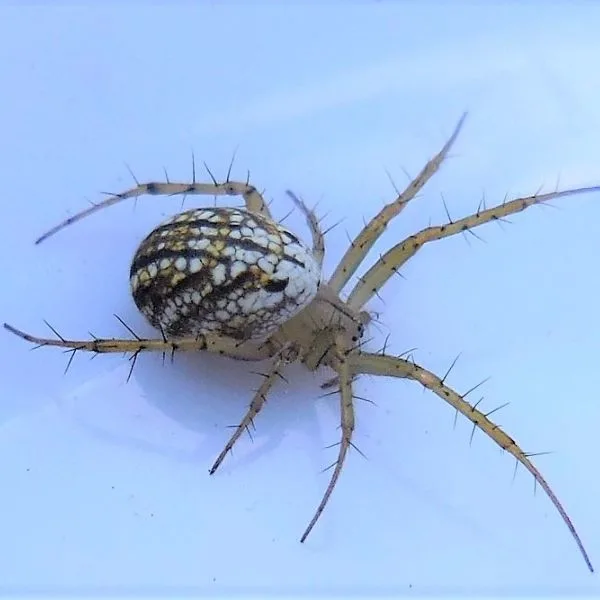
- Experience Level: Beginner to Intermediate
- Family: Araneidae
- Scientific Name: Mangora gibberosa
- Other Names: Lined Orb-weaver
- Adult Size: Up to 0.25 inches
- Lifespan: 1 year
- Average Price Range: N/A
The line orb-weaver spins large webs with a center of thickened silk that forms a whitish ring. You can identify this species by the black or dark brown lines on its whitish abdomen.
It has one long, dark line that runs through the middle of its abdomen and carapace. This line is flanked by two shorter lines that extend from the abdomen’s posterior but don’t reach the carapace.
The cephalothorax and legs of this arachnid are mostly green, but some of the legs appear translucent. The legs are spiny, and the underside of the two front pairs bear black lines.
As is typical of orb-weavers, this species uses its webs to catch prey. It is carnivorous, so arthropods make up the bulk of this arachnid’s diet. It waits for them to get stuck in its web before stinging them and feasting.
Thankfully, the lined orb-weaver is a non-aggressive species. The venom is also not toxic to humans. So you have nothing to worry about when you come across this species. Many can’t penetrate human skin.
FAQ
Still have unanswered questions about the spiders in Missouri?
You’ll find the answers you want here.
What do spiders in Missouri eat?
Spiders in Missouri and elsewhere feed primarily on arthropods like mosquitoes, beetles, roaches, and other arachnids. However, many species also eat animals like slugs and other small invertebrates.
Like insects, these arachnids are a successful group because of their ability to adapt their diet based on what is available.
Where can I find spiders in Missouri?
Your home is the first place to check if you’re looking for a spider. Chances are you’ll have a few lurking around your corners, windowsill, joint crevices, or attic. You’re also likely to find them outside the building, on your fenceposts, or in your garden.
If you’re looking for a specific species, check forests nearby or look up the range of the species you want to find. Missouri has hundreds of spiders, and some species are restricted to specific parts of the state.
Are spiders in Missouri venomous?
Yes, but to various degrees. Most spiders in Missouri don’t inject venom potent enough to harm you. While many inflict mild to moderately painful bites, others cannot penetrate your skin or leave you with a slightly itchy spot shortly after biting you. Only three spiders in Missouri are considered truly venomous.
The southern and northern black widows and the brown recluse are the only spiders in Missouri that inflict medically significant bites. These species are relatively easy to identify. If you suspect you were bitten by either spider, see a doctor immediately.
If you’re allergic to spider venom, the bites of nonmedically significant species may produce more serious reactions. See a doctor if your symptoms are severe. The symptoms rarely require medical attention.
Regardless of the species, most spiders do not bite unprovoked. You shouldn’t panic when you see one. You’re most likely to get bitten if you squash it or mistakenly press your skin against it.
Can a spider bite kill you?
Yes. But it is highly unlikely that you’ll die from a spider bite, especially in Missouri. Even black widows that have potentially lethal venoms rarely inflict bites that cause long-lasting damage to your system. Some estimates suggest that only about 1 in 100 bites from a black widow are serious enough to cause death.
See a doctor if a brown recluse or black widow bites you to minimize damage or scarring. Prompt treatment reduces the injury the venom causes.
Can spiders in Missouri see?
The answer depends on the species. Most spiders in Missouri have 8 eyes, but some have only 6. Some of them have keen eyesight in a pair or two, while others barely see. Many of these eyes also act as motion sensors, which allows them to move around easily and track nearby prey without seeing.
Can you keep a pet spider in Missouri?
You can keep pet spiders in Missouri. Some spiders are timid and run from people or bite when touched. However, many species are also comfortable around humans. While not necessarily cuddly, these species tolerate touch and will not bite you as long as they feel safe.
Keeping a spider pet depends on what you’re comfortable with. Since many spiders in Missouri don’t inflict painful bites, you can keep them as pets. If you want a pet spider that bites, you can keep it in an enclosure that provides a safe distance between you and the pet.
Wrapping up
Missouri is home to many different types of spiders. The species in this state are so diverse you’re bound to find striking patterns that fascinate you. Fortunately, these wonderful creatures also play vital roles in keeping the ecosystem balanced.
Spiders are carnivorous, feeding primarily on insects and other arthropods. This makes them effective natural pest controls, both in the wild and in people’s homes. Consider this before squashing a spider next time you see one.
If you’re like most people, you often don’t think of spiders as being highly diverse when you look at those around you. But there are hundreds of different types out there. Hopefully, this guide to the spiders in Missouri has helped you appreciate their diversity.
